
Journey of Metallic Money
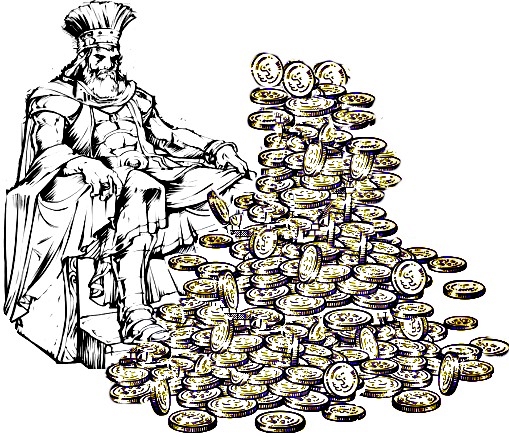
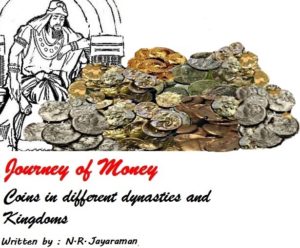
Era:-
Every one of the archaeologists or historians have recorded the periods of historically important events as BC, BCE, AD or CE. Before one read this article, it is important to know the time lines mentioned as AD, BC, BCE and CE because the same may confuse the readers in understanding the true position of periods in which the events have occurred.
Generally many think that BC is abridged notation for ‘Before Christ’ (Jesus) and AD meant ‘After Death’ (of Jesus Christ). While BC stands for the English phrase ‘Before Christ’, the word AD stands for Anno Domino which in Latin means ‘in the year of Lord’, Lord meaning Jesus Christ. Similarly the modern archaeologists and historians refer the periods as BCE abridged notation for ‘Before Common Era’ and CE for ‘Common Era’.
Therefore the periods referred to by the writers as AD or referred to as CE are one and the other same. Similarly periods shown as BC and BCE also convey the same period. Though initially the archaeologists and historians had mentioned the events as AD and BC, after the acceptance of the Gregorian calendar which has superseded all other calendars to become the international standard for periods, members of non-Christian groups of historians objecting to the mention of Christ in BC and AD have begun the use of CE and BCE to maintain religious neutrality. The period of count for the events begins with year One (1) in the Gregorian calendar. This is supposed to be the birth year of Jesus, or beginning of Common Era, although modern archaeologists often conclude that the birth of Christ had taken place four (4) years earlier.
Certain rules have been followed internationally for referring the periods of events which are mentioned as AD, BC, BCE or CE. The abbreviation such as BC, BCE or CE are to follow the numerical year mentioned in the narration, while the abbreviation AD would appear before the referred numerical year. For example while referring the event year in AD, the prefix AD stands before the year of event mentioned i.e as AD 100, AD 475, AD 1799 etc.
Similarly the abridged notation like BC, BCE or CE are always mentioned after the numerical year. For example the periods are mentioned as 100 CE, 100 BC or 100 BCE or 1799 CE, 1799 BCE or 1799 BC which means the abridged notation always follow the year of event and not affixed before the year like AD. The logic behind it or how it originated is not known except the fact that universally it is followed as a practice/standard.
Every one hundred years is called a century. Interestingly the First Century in both the era BC/BCE or CE/AD/ begins from year one (1) of the Gregorian Calendar. This means that the events which had occurred beginning from first year and ending anywhere in the region of 100th year in BC/BCE or CE/AD is referred as First Century. The second century begins from 101th year to 200th year and third from 201 to 300 and so on. Similarly every one hundred years block (1000 years) is called Millennium.
The illustration below will show how the events are to be understood on the historical events referred to as AD, CE, BC, and BCE.
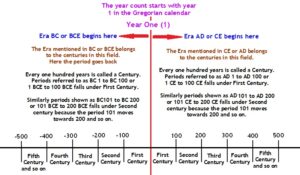
Many basic inputs on this article is from several sources such as books on Coins, wikipedia and several other websites, research papers, sites of auctioneers, Coin Collectors and Numismatic sites. The images of the Coins have also been similarly from various sites and they have been reproduced to show the structure of the Coins especially the signs and symbols impressed on them. My great many thanks to all of those sites from whom I could gather the information, though I have converted all of the images into black and white to enhance the images incused on them.
Metallic Money – Coins
The journey of Money in the form of Coins, Paper Currencies or Bank Notes and Crypto currencies have stemmed from several developments spread across millenniums. It will be interesting to know how the modern day state authorized metallic money issued in the name of Coins with certain face values was an unknown Metallic Money in ancient period of time and journeyed as shapeless, rugged, uneven pieces of metal in different thicknesses, sizes and shapes carrying certain signs or symbols over the years in various period of regimes and dynasties across the Globe.But everything began only from the Asiatic region.
This article analyses a little more than forty (40) important Kingdoms and Dynasties which ruled the Asiatic region and which have played an important role in the issuance of metallic Coins in various forms and shapes in different periods of time that paved the way for the birth of the present Coins several centuries later. Millenniums and centuries ago, when organized format of Money was unknown, only Goods, Grains and Metal pieces acted as shadow form of money (Commodity money) for procuring goods one needed or for trading purposes.
Modern era Coins are flat or round pieces of metal, used as legal tender, with non fluctuating but guaranteed face value within anywhere in the country which had issued them for the purposes of trading and transacting day to day business. They are minted in large quantities by the authorized Governmental authorities in controlled manner and techniques, and issued by another set of authorized authorities for the use of public in a state. The Coins issued will have standard weight, standard thicknesses, and definite shape incused with numerals, symbols and images and set face values. It will be interesting to note that the Coins are rarely counterfeited unlike Paper currencies, but are only hoarded by the metallic traders for their intrinsic metallic values or melt values. Therefore the metals for Coining are also carefully selected by the authorities to discourage hoarding of Coins.
All over the world, Coins are essentially issued on alloy (combination of metals) for day to day transactions for public, except issue of limited editions of Coins on Silver and Gold on special occasions as commemorate Coins, which of course are meant for Coin collectors and others but cannot be used by the public for day to day transactions. Otherwise Coins are usually made of metallic alloy with fixed composition of specific metals. Though the Coins are equated with the printed Paper currencies as legal tender with set face values, just because the Coins are generally hoarded by the metallic traders for their intrinsic metallic values, the Govt authorities curtail the production and issue of more Coins on precious metals compared to paper currencies.
The market value of the Coin amongst the hoarders is determined by the metallic content in them. Throughout the history one can notice that the ancient Coins have been issued on Gold, Silver and other precious metals whose face value gave the Coins their real value. However over period of time when the tendency to hoard the Coins increased, the metallic composition of the Coins were drastically altered to reduce the intrinsic value of the metal to prevent hoarding. Since the issuer of the Coin is that of the state authorities of the Government, whatever be the intrinsic value of the metallic Coin even with lesser content of the precious metal, they would typically be mandated to have the same face value as those Coins on precious metals. Any metallic Coin, whether in combinations of Silver or Gold or Copper even Lead issued with specific value will be Coin of the same value of Coins issued on alloy as far as the monetary status of the Coin is concerned.
Many wonder why the Coins are directly issued by the Govt while the Paper Currencies are issued by the autonomous bodies under the Govt. Though the British Govt of pre-republic India was issuing the Coins and Currencies directly, for administrative convenience and efficiency the issue of money was entrusted to the nodal Banker. Certain act has been enacted for the issuance of money by the Nodal Banker on behalf of the Govt, clearly defining their role and scope while the Govt can act as the watch dog over the nodal agency entrusted with the task of issuing the paper money. Coins are base of the Currency system and a legal tender with asset value whereas the Paper Currency is only a promissory note signed by the head of the issuing authority like Governor. The Coins does not have the promissory clause and have Seigniorage benefits to the government as Coins are supposed to have value in terms of the intrinsic value of the metal used.
The production of Coin for issue as metallic money can sometime result in a loss instead of a gain for the government because the metal used for the production of Coin has inherent metallic value. Therefore in certain periods of time, to offset the increase in the production cost of metallic money (Coins) the Govt who issue them resort to the practice of debasement of the metallic currency.
Debasement of the metallic currency refers to the process of lowering the metallic value of the Coins by adding inferior metal along with the precious base metal while minting them which has advantages like production of more Coins at reduced production cost. For example when 100 Coins of Re one Coins are minted with one Kg of ‘X’ metal costing Rs 100/-, then the total face value of 100 ‘x’ metallic Coins will be Rs 100/-.
Supposing instead of pure ‘X’ metal, combination of 25% of inferior metal plus 75% of original ‘X’ metal, costing Rs 75/- per Kg is used for the production of Re one Coins, then more Coins can be produced in the same overall cost meant for producing 100 % ‘X’ metal thus giving profit to the Govt by way of additional revenue. This is only an illustrated example to understand the factor. The second biggest gain will be the loss of melt value to the Coins affecting the illegal traders who hoard and melt the Coins for the production of other metallic products. This process of getting additional revenue in the production of money by debasing the metallic content of the Coins is called Seigniorage i.e the difference between the face value of the Coin and the cost to produce it.
It is very difficult to tell from where the concept of coinage emerged, but certainly the concept of modern day money has begun from the issuance of metallic pieces (like Coins) by various rulers and dynasties in different periods of time for internal trading purposes. The practice of exchanging metallic pieces for other goods as practiced in two or three different civilizations almost independently but simultaneously in different periods of time may have in turn inspired the rulers of the ancient period to issue such symbolic metal pieces for exchange of goods or trading purposes.
Coins were introduced for daily use for trading of all types of goods in Asia Minor, India and China beginning from 5th or 6th century BC(BCE). There are conflicting views as to who introduced the concept of Coins in those spaces though majority of the historians opine that the concept of Coins with definite weight, incused with some symbols or signs, was introduced by the Greeks living in Lydia and Ionia (located on the western coast of modern Turkey) in the 5th or 6th century BC(BCE).
However few other historians dispute the view to say that it was in India the concept of Coins began in the 5th century, followed by China and simultaneously and independently followed by the Lydians in natural manner. The historians belief that the concept of Coins may have emerged from India stems from Vedic records which has references to the issuance of metallic pieces of Gold and bars to the pundits who performed several Yagnas in ancient periods. Such references were also found in other texts especially that of Panini who wrote Ashtadhyayi. Panini was an ancient Sanskrit philologist, grammarian, and a revered scholar reportedly lived in the 4th Century BC(BCE) in ancient India.
Modern period of Money is characterized as Commodity money, Fiat money, Fiduciary money, and Commercial bank money.
The Fiat money is money backed by the Govt as legal tender by an order or authority such as Bank Notes, Currencies and metallic Coins with the state seal impressed on them.
Fiduciary money is money backed by trust between the issuer and the receiver such as Cheques which are issued against liquid money as a means of payment by trust and not on the orders of the Govt.
The Commodity money relates to goods such as Gold, Silver or even Spices or other Goods where the goods itself remains as the money.
The Commercial bank money can be described as book of accounts money – debt generated by commercial banks and transferred into the accounts of their customers, which can be used by them for purchase of goods or services from others.
Though the modern day concept of Money refers to Coins, Printed paper Currencies or Bank Notes, Withdrawal documents, Bonds etc extended to Credit cards and Electronic cash transfers form an important component of the payment system, this article traces the travel of money in the form of Coins beginning from Barter to the issuance of unorganized metallic pieces in the name of Coins under different rulers, ending up to the issue of organized metallic Coins followed by issuance of Paper Currencies several centuries later because the concept of money emerged only from the metallic money called Coins.
Journey of Coins – Barter
As said earlier, some form of shadow Money had always existed since millenniums. Only their appearance, shape, name or form have been different. Several materials or goods have been used as medium of exchange for transacting business and purchase of goods without naming them as Money though all of them played the role of Money in shadow.
The birth and growth of Money in the form of Coins stemmed from primitive Barter, a system through which goods in need were exchanged for other goods since no payment system in the form of Money was in vague anywhere in the world millennium years ago. Medium of Money was seen in indirect forms like Animals, Food grains, crude Weapons, Shells, Cowries, Leather and Metallic pieces which were used for trading beginning from 2nd millennium BC (BCE).
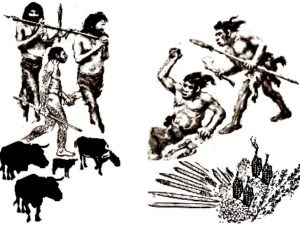
One need to know briefly about the Barter system from which various branches of Money transaction developed. The barter system has been in vague for several centuries long before money was invented and continue to exist even today in the form of Export- Import, where globally goods are exported to another country in exchange for other goods (imported), equivalent to the value of goods exported without issuance of money in any manner. The exchanged goods are then sold by the traders in the local markets to recover the money invested similar to the practice carried out in ancient times when Barter involved people in the same area exchanging goods of several kinds for goods they needed.
Mesopotamia Tribes and Barter

Archaeologists are unable to clearly decode how exactly the concept of Barter emerged even though everyone agree that it was initially started by the Mesopotamia tribes. Between the period 10000 BC(BCE) to 6000 BC(BCE), Animals were the front face of the barter system. The most popular form of barter was exchange of live stocks such as Ox, Cow, and Goat, Sheep etc. With the advent of Agriculture, Agricultural products such as Grains, other Plants and Vegetables came to be exchanged. Thereafter anything was exchanged for anything. Thus the grains and Animals were the facets of Money during those period. From the beginning of 1000 BC(BCE) which was the last leg in Stone age, weapons such as Knife and Spade and other crude Tools made of metals like Bronze and Copper played the key role of Tool money or Commodity money as against other items.
During Stone Age say between 10000 BC(BCE) to 3000 BC(BCE) tribes constituted the population all over the world and their standard of living or civilization was almost identical everywhere. As civilization began to dawn, gradually they learnt the art of making tools from stones, cultivated Food grains and made essential articles for daily use such as Clay pots, which suited their atmosphere and needed for Cooking food or preserving them. Such goods were exchanged by groups with goods needed. The trend began to surface mainly in China where the Metal Tools began to be made in crude manner. Those crude round shaped Metallic Tools became commodity money. Thus the goods of many types became commodity money by themselves.
Mesopotamia is a name for the area of the Tigris–Euphrates river system, roughly corresponding to present day countries like Iraq, Syria and Kuwait including regions along the Turkish-Syrian and Iran–Iraq borders. When bartering emerged, the barter which was believed to be introduced by Mesopotamia tribes for exchange of goods for Goods, confined to local territories within their space and land.
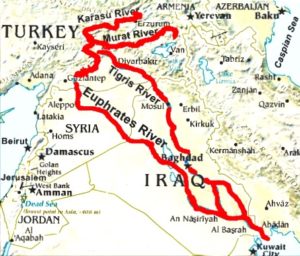
Areas under Mesopotamia
However while Mesopotamia tribes confined barter within local territories, it was Phoenicians who extended the system of exchange of goods to other countries across ocean. The Phoenicians were not Greek, Roman or Italian. They were pre-Arab people who lived in a narrow tract of land along the coast of modern Syria, Lebanon and northern Israel. Phoenicians appears to represent confederation of maritime traders as middle men rather than citizens of a defined country.
The Babylonians improved the barter by exchange of Goods for Food, Tea, Weapons, and Spices. Salt was one of the most popular item exchanged and one can imagine its value when even salaries of Roman soldiers were paid in the form of Salt. Thus Salt was treated as Money in shadow at one period of time. Grain, Oils and Textiles were taken from Babylonia to foreign cities and exchanged for Timber, Wine, precious Metals and Stones, all of them acting as Commodity money. In addition, merchants from other countries travelled to Babylonia to exchange their goods.
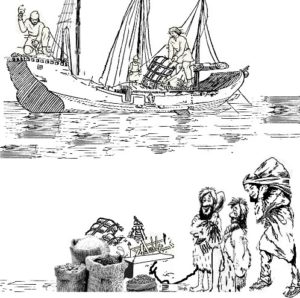
As time passed, due to difficulties encountered in transporting heavy loads of live stocks of animals from faraway places, people began to feel that such heavier stocks could be exchanged locally against heavier stocks while the unavailable food grains in their region could be procured and brought from faraway places in exchange for food grains needed by the other. This laid the road for export-import trading of modern times.
One of the Greek archaeologists recorded the primitive form of trading by barter between tribes and civilized merchants in a very interesting manner. The merchants of one nation may reach the shore of unknown place and after anchoring the ship, they would lay out their goods on seashore and retreat back to the ship awaiting response from the public in that unknown area. Sometime later, people from the unknown area would appear, see the goods, take away some of the items, only to return back after some time to keep other goods available with them in exchange against the goods they have taken and retreat back into their villages. Till mid of night the merchants from the ship would not come back to the shore, but late night they would come, take away the new things leaving back excess goods if remained any in the ship as goodwill gesture and retreat back to the ship for onward voyage. Neither the sailors on board nor the people in land interacted directly with each other to negotiate what was exchangeable between both. This is not a story, but was in practice for centuries as saw by him in the seashore of some nations. Centuries later such forms of bartering too laid additional path for Export- Import trade in alien lands.
Metals – Shadow commodity money
As said earlier, ancient Mesopotamia was the most influential civilization and first known in world history. Humans first settled in Mesopotamia in and around 14,000 BC(BCE) and lived in small settlements. Five thousand years later they learnt the art of domestication of Animals and the development of Agriculture to produce food grains which became one form of commodity money. Beginning from 2nd millennium BC(BCE), money in the form of commodity money was found in use in different forms. During the said civilization, strong weapons were made with Iron, Bronze and Steel. The utensils were also made with Copper and Steel and ornaments were made with Silver and Gold. All of them could be viewed as commodity money, though the concept of commodity money was unknown then. Thus metals like Iron, Bronze, Copper, Silver and Gold became the most valued item for exchange against other goods like Animals, Food grains, Shells and Cowries though all of them were also in use for transacting businesses.
The archaeologists say that in the later part of the Mesopotamia civilization, there was an interesting turn when transactions in trade were done based on a regulated system of exchange of metals against goods by written law i.e. a given amount of food grain or Seed would be worth so many Oz weight (like Kg and gram) of Silver or Bronze or Gold metal for example. The manner in which the most valued metals like Gold, Silver, Bronze, Copper or Steel with specific weight were exchanged against grains of specific measure indicate that the concept for an organized format of Coin had been seeded then. Therefore when someone needed specific goods, they would cut the Silver or Gold bar available with them into pieces and exchanged them with the goods needed by them. Thus the non-standard, crude shaped metallic pieces began to be used unknowingly as invisible form of metallic Money suggesting that some kind of divisions in the value of money begun to surface in this period because the metals used to be cut to pieces and exchanged against goods.
Since some of the most valued metals came to be exchanged in barter, the merchants and traders kept the Gold and Silver bars which were considered precious metals, safely in tall towers in the places of worship, treating them as precious commodities for exchange (as if they were real time money) even though the organized format of Coins and Currencies did not emerge. The places of worship were akin to banks to store the metals in safe custody. One would agree that only such ignorant and isolated acts laid the foundation stone for the emergence of banking system and issuance of metallic Money though it took several centuries for it to surface.
Several years later, Cowries and Shells which were available in plenty in the shallow waters of the Pacific and Indian Ocean and in China became important commodity money in barter and for transacting the businesses in China because the Cowries and Shells were used to make ornaments by the tribes and the culture spread to other general public in other areas beyond China. Even when the modern era dawned, the Cowries continued to remain an important item of exchange against well formatted money in some of the countries.

In the second pre-metallic stage, the medium of exchange was article commonly found and valued for their utility when the utility of goods or materials became the measure of value against other items. As time elapsed the metals increasingly represented the stored value of goods for exchange in place of Shells and Cowries. In the history of Money, only when the exchange of metals began, the concept of Metallic Money emerged for transacting the business as every metal had their own significant values and usage depending upon their availability.
Since Cowries were not easily found in the northern side of Asiatic regions, people replaced it with Cowries made of metallic materials such as Bronze, Gold, and stone. At the same time as per some of the archaeologists, the earliest form of metallic Money was also seen in use in China in and around 1000 BC(BCE). Similarly elsewhere in the world, in third millennium BC(BCE) i.e three thousand years before start of AD(CE), in Egypt, metallic Money in the form of Gold bars were seen in use. However how were the exchange values arrived at between the Gold bars or the Cowries, what were the individual measured unit values of them etc could not be ascertained as no organized money format existed then.
Foot steps of Coins- Gold and Silver metallic pieces
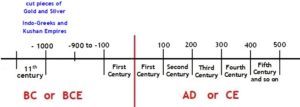
In or around 1000 BC(BCE), while some kind of metallic money was in use in China, in the territories held by the Indo-Greeks and Kushan Empires whose influence had then spread to J&K, northern parts of India, Afghanistan, and Peshawar etc in Asiatic region, cut pieces of Gold and Silver were seen in use for transacting business or for purchase of goods (as Money) which confirm that indirect form of metallic money was in use in China, Egypt, Indo-Greek and Kushan regimes simultaneously almost in the same period of time. Interestingly cut metal pieces issued by Kushan rulers like Coins were also found to have been issued in an unorganized manner. Several of those metallic pieces had no seal or signs or images incised or punched on them but they were termed as indirect Coins by the archaeologists.
Reference to Coins in Vedas and Puranas

Many archaeologists point out to the fact that the earliest references to Coins in the Indian context have been found in the Vedas from 15th century BC(BCE). Though Vedas were primarily religious texts of Hindus, there were numerous references to a specific word ‘Nishka’ which is believed to be the earliest specimen of Indian coinage. Nishka means pure and honest and it referred to pure Gold in the ancient India. In Rigveda there is repeated mention of the word Nishka, a word which in later Sanskrit is decoded as a Gold Coin by some scholars. Though the exact meaning of Nishka is unclear, it is generally believed that what is referred to as Nishka in Rigveda refers to Gold Coin. However how were the Gold Coins valued against other items, what were the individual measured unit values of the Gold Coin etc could not be ascertained as concept of organized money format did not exist then. Also whether they were issued in mass scale in the form of remuneration or salary for the work done, or gifts given for specific purposes to the public against something performed or transacted is also unknown because the Coins with some signs were issued only by the rulers and not allowed to be prepared by the public themselves. All that one know is that the Gold piece in the form of a Coins have been in use.
There are numerous references in Puranas and even in Mahabharata and Ramayana texts that in the Yagna conducted at various stages, lots of gifts have been given to the Brahmin priests who had performed the Yagna, and the gifts were mostly that of round shaped Gold Coins thus confirming that Gold Coins have been viewed as precious metal in terms of value compared to other metals or items and could be exchanged for any goods in any form even during the period of Vedas in the Asiatic region in the post metallic age.
The historians also rely upon the text of Panini who wrote Ashtadhyayi (Sanskrit treatise on grammar written in the 6th to 5th century by Panini a grammarian in India) in which he has mentioned certain names like Satamana, Nishkas, Sana, Vimastika, Karshapana and various sub-divisions in them, all of which refers to some kind of metallic money and therefore argue that the concept of Coins may have been known to Indians long, long before Lydians introduced it. Karshapanas were basically Silver Coins stamped with few signs and symbols issued during the period of Mahajanapadas and Janapadas rule.
Status and facets of Coins in different periods of time
Before proceeding further, the facets of the Coins in different periods of time under different rulers need to be addressed. The initial Coins issued in various metals were seen incised with some kind of signs or marks or images of the Kings. Symbol or image is a sign or word that revealed vital information on the rulers or the dynasties similar to conveying messages by symbolic representation in the form of marks or symbols. The same has been the case of symbols found on the Coins issued or used by different rulers. The incused signs, symbols or the marks on the Coins revealed the period to which they belonged or civilization or names of the Kings of different dynasties who issued them.
The archaeologists believe that Chinese too may have started using coinage simultaneously with Lydian as early as from 5th century BC(BCE) through the exchange of Cowrie Shells. During the period 475 to 221 BC(BCE), Gold Coins were reportedly issued by the State of Chu in the Warring States period. The Warring States period, also called contenting States period, refers to small feuding Chinese Kingdom in which several rival Chinese states battled viciously for territorial advantage and dominance, ultimately establishing a unified Chinese Empire in the year 221 BC(BCE). The Warring States Era is considered to be a fascinating period in Chinese history as far as the coinage is concerned. In the said era, one of the Kings namely Ying Yuan had issued 3 to 5 mm thick, stamped Gold Coins indicating the monetary unit or weight of the Coins. There are conflicting claims by some scholars and archaeologists who suggest that India too had her own coinage in the 8th century BC much earlier than Lydians. But all such versions still remain in dispute.
In Asiatic region, many symbols have been found impressed or cast on the Coins revealing the identity of the issuing rulers or the dynasty. Remember that all the Coins issued by various rulers were not real time money with individual values set on them, divisions or denominational values attributed to various Coins issued by the same ruler etc since neither the mode of issue of Coins nor the manner in which they reached the hands of public remain sketchy and unknown.
Each of the symbols incised on the Coins issued during the period of different rulers conveyed their own meanings and threw light on the rulers or dynasties which issued them. For example the Three-arched Hill, surmounted by a Crescent or Peacock is said to be a symbol of Mauryans dynasty. The Three-arched Hill symbol found on the Coins could be attributed to the Shunga dynasty. The Coins with Three-arched Hill, Fish, and Elephant symbols may have been issued by the rulers of Pandiyan Kings in south India. The typical symbol of the Chera dynasty was Bow and Arrow. Exchange of a Coin with simple representation of Cow or Bull or Coins with impressed images of Cow made it easier for trading with other essential commodities instead of physically bringing the Cow or Bull to the exchange point. The person with the Coin of Cow or a Bull could collect the Goods and later hand over the Bull or Cow to collect back the Coin exchanged.
The earliest Coins of India were commonly known as punch-marked Coins with no defined shapes and they were mostly uniface (one side blank while the other side had some symbols). Secondly, those Coins were also without inscriptions in contemporary languages. Those unique characters on early Indian Coins made identification of Indian Coins with that of their contemporaries in Greece or Roman.
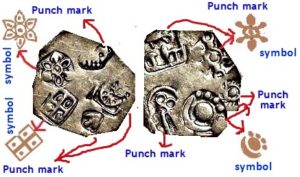
On varieties of metallic Coins issued in some form or the other over millenniums – round or rugged or square or uneven in shape- some symbols were always seen impressed on them. Coins with such impressed marks were termed as punch marked Coins by the archaeologists and numismatics. Such Punch-marked Coins excavated belonged to the 6th century BC(BCE) extending up to the 3rd or 4th century CE (AD). Most of the punch marked Coins were Silver though some rulers had even issued other punched mark Coins on Copper. The origin of symbols which are found on the punch marked Coins could be traced back to the prehistoric times. Over the intrigue on how almost similar symbols have been used by different rulers to incise them on the Coins, some of the historians suggest that the marks adapted by them may have been the seals of Harappa or Indus scripts (Indus valley civilization) which can be seen below.
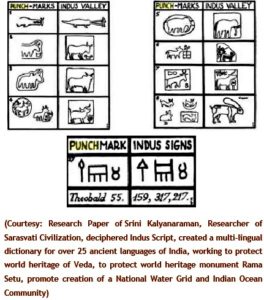
The Coins issued during various dynasties were shapeless, oval, square, oblong or rectangular in shape issued with certain weight standard by some dynasties while in the period of other dynasties, the standard weight system was unknown. Initial Coins were issued with two punch marks and later the punch marks exceeded even up to five or six.
During 3rd century BC(BCE), while Gold bars were found in use in some parts of Egypt for trading, in the next 100 years i.e. 4th to 6th centuries BC(BCE), metallic money came to be used in Asiatic region during the rule of Gupta regime. The concept of bimetallic Coins may have emerged in their period as may be seen from the discovery by the archaeologists of Gold Coins debased with Silver and Copper Coins debased with Bronze belonging to their period. In Kalinga which was one of the most important Buddhist states under Ashoka, punched Silver Coins and Coins made of Copper, both with specific value commensurate to their weight have been found issued. Those Silver and Copper Coins of pre and post Maurya period excavated in Orissa belonged to 3rd century and mid 5th century BC(BCE). The punch marked Coins had the images of Moon, Sun, and Animals like Lion, Horse, and reptiles like Snakes, Scorpions and Fish etc inscribed on them.
Few archaeologists opine that much before the Britishers introduced Coinage in India, the concept of coinage had been already introduced in India during the period of Greek rulers. But unlike punch-marked Coins issued by the rulers in India, Coins issued by Greeks were round in shape with signs or symbols incised on both the sides of the Coins and minted using Silver, electrum and Gold too. The Indian punch-marked Coins, both ancient and later periods found were irregularly-shaped – some square, some rectangular and few others round in shape but precisely weighted. Many of those Coins called Karshapana were punched with religious symbols like Swastikas, Animals, Trees, Geometric shapes, Divine elements etc. The design elements on the punch mark Coins belonging to the earlier period were simple, but on the Coins issued in the later period, the design elements were complex and stamped (punched) with different punches.
Thousands of punch-marked Coins excavated in different regions in Asia, particularly in few parts of India, were found buried in hoards indicating that they may have been preserved by people as wealth. In those hoards of Coins excavated, hundreds of symbols of varying styles like Dots, Circles, Radiating Sun rays, Wheels, Ladder, Swastika, Animals like Lion and Buffalo, Peacock, Crescent, Rectangles and Squares, Trees, Branch of Tree, Elephant, Hare, Bull, Female and Male Deities, Scorpion, Fish, Goat, Dog, Hill in the form of three or more arches sitting one over the other, Victory symbol called Jeyadheva, images of the Kings or ruler were seen though maximum of six symbols were found incised on each of the Coins. Some Coins even had Tantric symbols and images of few Goddesses besides the image of Lord Shiva. As the popularity of Coins increased, incised punches elaborating the artistic design elements became stylized. The symbols of Plants and Animals got replaced with that of portraits of their patron Deity or Deities and legendary Heroes of their time or portraits of rulers. Interestingly many of the general seals or signs incised on the Coins matched with those of Indus and Harappa signs and symbols. See below few of them.
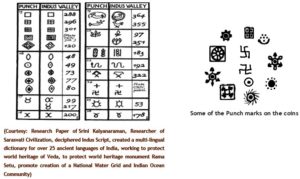
However, the archaeological findings of punch-marked Silver and few Copper Coins of post Maurya period suggest, that the earliest instances of Coin circulation and usage of Coins in India could be traced back to 6th to 5th century BC(BCE). Most of the Coins were rectangular in shape, occasionally square or round, but none of them had clean edges thereby suggesting that they may not have been cut with punch die or molded in some die to maintain uniformity. In respect of square and rectangular shaped Coins which were not uniform in size and shape, but uniform in their thicknesses, one tends to believe that they may been cut from bigger size metallic sheets and not individually molded. The symbols which also do not show artistic or aesthetic excellence in their appearance may have been punched on the Coins with some hand made punch dies. The irregular shapes and sizes also indicate that the value of Coins may not have been based on specific weight and only the property of the metal used may have been the consideration for assigning the value in terms of money.
Ancient Coins were made from Gold, Silver, Electrum, Copper, Bronze or other Alloys. Few of them were consistent in weight, implying that the issue of Coins in different metals may have been intended to have a set value for each of them. The early Electrum Coins which were bimetallic Coins were assessed to have been minted for over fifty years, and by the middle of the sixth century they could have been replaced by Coins of Silver. The fineness or purity of the metal used for Coining in Gold and Silver were closely monitored by the rulers of Greek and Roman. Coins issued on Copper and its alloys were not common until the later fourth century BC(BCE) and they were called token or Fiduciary Coins. Less care was given to the weight of individual Copper Coins and to the purity of the metal or alloy used. The archaeologists say that while issuing the token or fiduciary money in the form of Coins, the Greeks may have issued Coins mainly in Bronze, Copper alloyed with Tin and the Romans may have used alloy metal mixer of Copper and Zinc for the issue of higher denominations. One of the possible reason why the Coins have been issued in different metals could be to indicate different values of the Coins. The Gold Coins were the highest valued ones in trading, while Silver the next valued, and the Copper the last.
Another interesting period in the Indian coinage in post Maurya period has been the emergence of large no of smaller states in northern India ruled by different dynasties after the fall of Gupta and Indo-Greek rulers. Punched mark Coins made of Copper, Silver and Gold have been issued by many based on the weight system of Abrus precatorius seeds (Red seed with black mark on one edge) and Coins have been called in the names like Nishka, Karshapana, Satamana, Vimshatika etc. There was however decline on the issue of Coins in post Gupta period compared because of decline in the trading activities and frequent invasions.
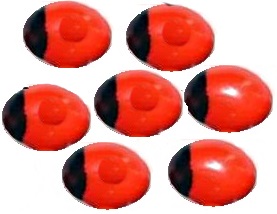
Abrus precatorius seeds
The Post-Mauryan coinage of Gandhara witnessed the production of coinage in Gandhara in the northwest, and more particularly in the city of Taxila which is in modern-day Pakistan following the breakup of the Maurya Empire that ruled in 321-185 BC(BCE). Taxila was once the capital of Gandhara which was ruled by different dynasties over period of time. During the period of different rulers, both inscribed and non-inscribed (without punch mark) Coins have been issued in Taxila either in Gold or in Copper. When Mauryan central power disappeared, several small independent entities were formed, which started to strike their own Coins till the rise of Gupta Empire in the 4th century AD (CE).
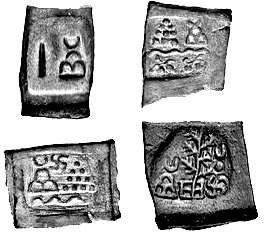
Some of the Taxila Coins
Courtesy: http://en,wikipedia.org/wiki/post-Mauryan_coinage_of_Gandhara
Coins in Mahajanapadas and Janapadas

From the period of rule of Mahajanapadas which was era of Iron Age, various rulers have issued Coins in some form. Mahajanapadas were set of sixteen Kingdoms which sprang up when the tribes of the late Vedic period formed their own territorial communities in the areas they lived. The permanent areas of settlements where they lived mostly centered around the present day Bihar and Uttar Pradesh. Initially the small settlements were called Janapadas and when more Janapadas merged together they became Mahajanapadas. The Janapadas were headed by some rulers chosen from amongst the locals and most of such states remained monarchical in nature barring one or two which followed democratic system of governance.
At the era when the use of Iron was more, several small territorial states turned into larger states either by annexations in war or by voluntary mergers with bigger states which begun to be called Mahajanapadas. The rulers of those Mahajanapadas issued Coins of their own in the name of Puranas, Karshapana or Pana which were some format of money but not based on some standard, nor were uniform in size and shape though in some Janapadas the weight system of the Coins showed different values for different Coins issued.
The punch marked Coins were of two types, one of Mahajanapadas period and the other Janapadas period. The Coins issued by Mahajanapadas were specific in weight, impressed with four or more symbols though the symbol varied significantly from metal to metal. The Coins of Janapadas bore only one symbol incised on them. Between mid 6th and 4th century BC(BCE), when the states of Janapadas and Mahajanapadas were gradually absorbed into larger Magadha Empire, Coins began to be incised with five symbols.
Gandhara was one of the major ancient Indian Kingdoms in Mahajanapadas period covering areas in north-western India, some parts of Pakistan, eastern Afghanistan and valley of Peshawar on the northern side of the Kabul River. The Kingdom of Gandhara existed from the 6th century BC(BCE) to the 11th century AD(CE). The Mahajanapadas of Gandhara issued bent Silver bar punched with seven symbols while the Janapadas Kingdoms in the then Kashi, Magadha, Koshala, Avanti, Dakshina Koshala, Ashmaka (a region of ancient India around river Godavari), Vanga (It was located in southern Bengal) and Prachya (Kingdom in eastern region) produced Four-Symbol Coins.
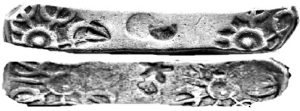
Bent bar Coins of Mahajanapadas
As said earlier, the earliest Coins issued were known as punch-marked Silver Coins though Copper punch-marked Coins too have been issued by few rulers. The first documented sets of coinage were that of Punch Marked Coins in Silver and Copper, issued between the 7th to 6th century BC(BCE) and 1st century AD(CE). The symbols or images were seen manually punched with a separate punch tool because of which there was no uniformity in depth or fineness of the images punched.
The Coins of the early tribal republics of the 2nd century BC(BCE) bore the names of the tribes and the places on the Coins in the Brahmi scripts. During 600 BC(BCE) there were eighteen tribal rulers in Mahajanapadas. In course of time the weaker Kingdoms either submitted to the stronger Kingdoms or were eliminated ultimately leaving strongest four Kingdoms to survive. The rulers in those four too have issued Coins mainly in Copper, though some issued Coins in Silver also.
Kingdom of Lydia – Introduction of Coins

It was in 6th or 5th century, i.e. 600 BC(BCE) to 500 BC(BCE), Coins were first introduced as a method of payment. Lydia was an Iron Age Kingdom in western Asia. In 550 BCE(BC), Croesus, the King of Lydia (561-546 BCE) reportedly issued Coin in Gold and Silver by minting them in Sardis, an ancient city in Turkey. They are also credited with the issue of the first bimetallic Coins made of Electrum, an alloy combination of Silver and Gold. The metals were weighed at each transaction before minting. They were stamped to indicate their fineness and guaranteed for their purity before using them to mint Coins.
The first recorded Coins were minted in around 500 BC(BCE) in Lydia, a Gold-producing country in the west of Asia Minor. While everyone agree that it was under Croesus the Coins were minted first, some archaeologists counter the claim to say that most of the Coins were minted first during the regime of a Lydian King called Alyattes-I, the fourth king in Mermnad dynasty.
Mermnad dynasty is the name of the royal family of ancient Lydia which ruled during 680-546 BC(BCE). Whatever it is, the fact remains that the first Coins appeared in 500 BC(BCE) were minted only in the Lydian region of Anatolia’s Aegean shore in Asia Minor, which is the present-day Turkey to confirm that a regular system of coinage must have been in vogue by mid 5th Century BC(BCE) itself for trading besides Barter. Though the Coins were minted and released by the state authorities in organized manner, what were the values of each of the metallic Coins issued, the divisions or denominational values of the Coins if any and/or the measured unit values of each of the divisions in the Coins etc could not be ascertained as no organized format of money existed. All that we know is that the metallic Coins have been issued as a means of payment.
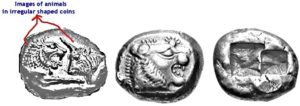
Some of the Coins belonging to Lydian Kingdom
Attribution: Classical Numismatic Group, Inc. http://www.cngCoins.com
Coins in Kingdoms of Surasena and Vatsa
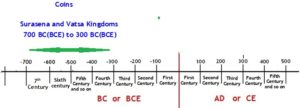
Kingdom of Surasena was ruled by Yadav clan Kings in the ancient Indian region corresponding to the present-day Braj region in Uttar Pradesh, with Mathura as its capital. The Surasena Kingdom and Vatsa Kingdom which ruled from 7th Century BC(BCE) till 3rd century BC(BCE), was one of those in the sixteen Mahajanapadas. The Surasena Kingdom was established by King Surasena who later became the first disciple of Lord Buddha. He ruled till the 6th Century BC(BCE). Not much details are available on his successors. The Surasena Kingdom lost their independence due to the annexation of their territories by the Magadhan Emperors.
Coins have been issued during the period of Surasena rulers. The Coins issued by the Surasena rulers bore several symbols similar to those punch marked coins issued by the previous dynasties in Mahajanapadas. The Coins of Surasena kingdom show symbols such as Turtle, Hill, Elephant, Swastika, Banyan tree, something like a Barrel, number of other symbols, one amongst them being a standing female Goddess. Their Coins had influence of Indo-Greek coinages in design elements.
Udayana was the King of Vatsa Kingdom which ruled from 6th BC(BCE) till 5th BC(BCE) with their capital in Kusumbini (in present UP). The rulers of Vatsa Kingdom, another in the four Kingdoms that survived in Mahajanapadas have also issued Coins. The Coins issued by them show the symbols of Bull on one side of the Coins and a Tree in railing with some other symbols on the other side of the Coin. The Coins were also found inscribed with the name of the king. Few variations were seen on the symbols inscribed on the Coins issued by them. While the symbol of Fish was seen inscribed above a Lion in few of the Coins, in few other Coins, the Fish was seen incused below the Lion. Strangely in some of the Coins, symbol of Fish was completely missing.
Coins of Pratharajas
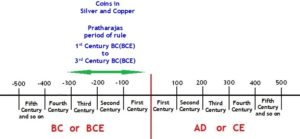
The Paratharajas are a little known dynasty consisting of Iranian people who ruled part of Baluchistan probably during the 2nd and 3rd centuries BC(BCE). Some historians feel that their rule began in the first century and they ruled from 125 BC(BCE) till 300 BC(BCE). The name of their first King is reportedly Shahi Yolamira whose Coins were first issued by Pratharaja dynasty and almost eleven Kings have ruled in their dynasty.
Several Coins have been issued during the rule of the eleven Kings with most of the Coins showing the burst of a bearded King, or a clean shaven King (may be that of the then ruling King), The King in standing posture with hair in turban and legend in Kharoshthi script on other side. Most of the other symbol seen on their Coins were both right turning Swastika as well as left turning Swastika. Though they were small group of rulers, they have also issued Coins in Copper and few Silver Coins during their period of rule. The design elements on their Coins suggest that they may have been influenced by the Coins of Greek rulers.
Generally the legends on their Coins were in Brahmi and Kharoshthi scripts. The Kharoshthi script is an ancient script used in Gandhara. Some also say the script could be that of Indo- Bactrians (Greek).
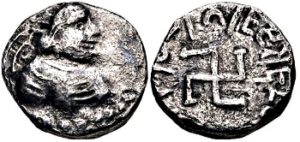
Attribution: Classical Numismatic Group, Inc. http://www.cngcoins.com
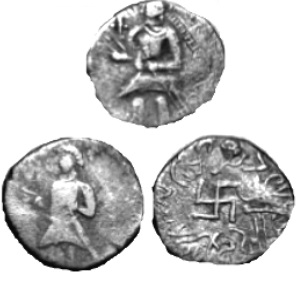
Some of the Coins issued during Pratharaja’s rule – See symbol Swastika in reverse compared to above
Coins in Ancient Greece

In and around 650 BC(BCE) when Lydians introduced Coins, incidentally the ancient Greek rulers and merchants in Asia Minor too have issued Coins. Asia minor was in Asia engulfing several areas in the present Turkey, Azerbaijan, Armenia and Georgia.
In around 600 BC(BCE), each city in ancient Greek world were minting their own Coins stamped with recognizable symbols of the city. In ancient Greek world over 25 cities used the Coins in the name of Drachma Coins along with Coins in the name of Stater. Since the Greeks introduced weight standards, the exact exchange value of each of the Coins were determined by the quality and content of the Silver used on the Coins (as issued by each mint) and the values also differed from the Coins issued in each city. Value of the Coins were determined by the material the Coins were made of and their weight. A Gold coin was worth more than a Silver coin which in turn was worth more than a Bronze Coin. A heavy Coin would buy more than a light weight Coin. Thus the face value of the Coins were determined by the weight and not by the Coin itself.
Influenced by the Coins issued by Lydians, it was Aegina who first issued Coins in the ancient Greece, in the name of Stater and Drachma in the year 550 BC(BCE) with distinctive symbols impressed on them. The initial Coins bore symbols like Sea turtle and a Square divided into eight parts and subsequent Coins bore images of Land Tortoise on the front side with a Fish in one of the divisions of the Four Squares on the back.
Generally the Greek coins had portraits of Kings, Signs and Symbols, Deities, Birds, Animals Popular Heroes in Greek etc.
The Coins were made by hand and stamped with design elements engraved on a steel or Bronze Die. A blank piece of Gold, Silver, Bronze or Electrum was put between two moulds and struck hard with a hammer to stamp the designs on the Dies on to the blank Coin piece.
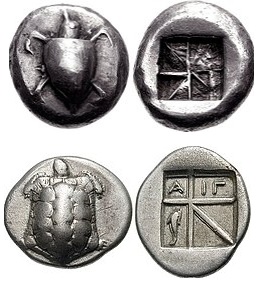
Silver Stater and Drachma of Aegina – See the difference in the symbols of tortoise
Attribution: Classical Numismatic Group, Inc. http://www.cngcoins.com
In the history of Greek Coinage, four periods played important role in shaping the development or the status of the Coins. The four periods were Archaic, Classical, Hellenistic and Roman Coinage periods.
The Archaic period was between 750 BC(BCE) to 408 BC(BCE) when Persians annexed the land.
With the annexation of the land by Persians the Classical period commenced in 480 BC(BCE) and ended sometime at 323 BC(BCE) till Alexander the great conquered the territory.

Classical period coins
Attribution: Classical Numismatic Group, Inc. http://www.cngcoins.com
After Alexander conquered the territory in 323 BC(BCE), the period came to be called Hellenistic period which lasted till 30 BC(BCE).
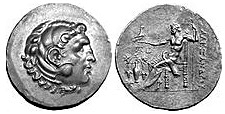
Hellenistic period coins
Attribution: Classical Numismatic Group, Inc. http://www.cngcoins.com
From 30 BC(BCE) onwards the Romans Kingdom took over the reins of Greek world and the period began to be called Imperial Roman period i.e modern Greek period. Rome’s Imperial Period was its last, beginning with the rise of Rome’s first emperor in 30 BC(BCE) and lasting until the fall of Rome in AD 476.
The Greek cities continued to produce their own Coins for several centuries under Roman rule. The Coins produced during this period were called Roman provincial Coins or Greek Imperial Coins.
Roman provincial Coins were minted within the Roman Empire by local civic rather than imperial authorities. Those Coins were often continuation of the original Coins that existed prior to the arrival of the Romans. Because so many of them were minted in the Greek areas of the empire, they were referred as Greek Imperial Coins.
Coins in Haryanka Dynasty

Magadha was an ancient Indian Kingdom in southern Bihar, and was counted as one of the sixteen Mahajanapadas. The ancient kingdom of Magadha is heavily mentioned in Jain and Buddhist texts. It is also mentioned in the texts of Ramayana, the Mahabharata and Puranas. Magadha played an important role in the development of Jainism and Buddhism, and two of India’s greatest empires, the Maurya Empire and Gupta Empire originated in Magadha. They both gained importance in the issuance of coinage.
Though there is very little information available on the early rulers of Magadha, it is known that it was initially ruled by the Haryanka dynasty for few hundred years. One of the most important Kings in the Haryanka Dynasty has been King Bimbisara. Though the dynasty was established first by his father King Bhatiya, Magadha flourished only during the period of Bimbisara who reportedly even offered his throne to Lord Buddha when he was camping in Gaya in the present state of Bihar. According to the Buddhist text Mahavamsa, he ascended throne at the age of fifteen and ruled from 544 BC(BCE) to 492 BC(BCE). Thereafter Ajatashatru, Udayin and Nagadasaka took over the Haryanka dynasty and ruled till Shishunaga dynasty overthrew them in 413 BC(BCE). Many Coins have been issued under the period of Magadha rulers.
Magadha’s earliest Coins were in Silver Coins called Mashaka roughly weighing 7.6 gm in weight which had inscription of Six Arms symbol. The next was thinner coin weighing 5.5 gm with same symbol. Some of the Coins weighed 3.3 gm and were square with rugged edges. Further Coins issued by them show additional symbols punched on them like Elephant, Bull, Hare, Sun, Chakra/Wheel and few others other symbols. However all those symbols were not punched on one coin. At best maximum of six to seven symbols were seen punched in each of the Coins. Even in Magadha rulers period no regulated system of coinage surfaced. What were the values of each of the metallic Coins issued, the divisions if any and the measured unit values of the Coins etc could not be ascertained as no organized money format existed even then.
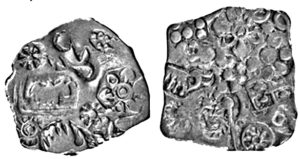
Coins of Haryanka dynasty
Coins in Shisunaga Dynasty
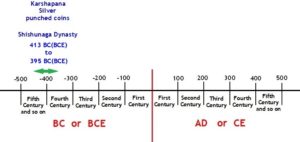
Period between 480 to 323 BC(BCE) was called classical period during which the punched design elements on the Coins gained more attention and modified with additional symbols. Within this period the third ruling dynasty of Magadha called Shishunaga dynasty came into power after overthrowing the Haryanka Kings. King Shishunaga was the founder of the dynasty in 413 BC(BCE) and ruled till 395 BC(BCE) with its capital in Rajgir and later moved to Pataliputra both of which are in present state of Bihar. Around 420 BC(BCE), perhaps with the ascension of King Shishunaga, the standards of Karshapana Coins got changed not only in size but also in thickness.
Firstly the Karshapana which featured with four punches, got changed to a five punch design Coins. Two of the punches were consistently a Solar Disc and a variety of the Six Arm symbol while the other three varied in Coins.
During the rule of Shishunaga, some of the Coins issued with changes were struck on Silver in various denominations like 1/2 Karshapana, 20 Mashaka and 25 Mashaka, besides Karshapana. These names confirm that differential valued Coins have been issued in their period of rule. The Mashaka weight followed in Mahajanapadas period was abandoned and replaced with Karshapana standard which was roughly 3.5 gm. Masha meant weight and one Mashaka denoted the Coin weight equivalent to 88 mustard seeds.
The highest denomination in the Mahajanapadas period was called Nishka, the next lowest as Swarna and lowest amongst them as Mashaka. In the history of coinage this was the period when the divisions in the Coins were seen as the value was decided against weight of mustard seeds. What was the standard weight of those 88 mustard seeds however remain unknown. Even in this period of time no organized format of coinage had taken root. Since no details on who issued the Coins- the ruler or the civic authorities, the manner of issue, whether they were payments for the services rendered, salary or other details etc remain unclear.
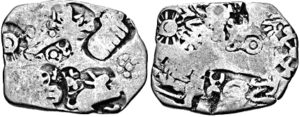
Coins during the Shishunaga dynasty.
Attribution: Classical Numismatic Group, Inc. http://www.cngCoins.com
Coins in Nanda Dynasty

The Nanda dynasty ruled northern part of the Indian subcontinent during the 4th century BC(BCE) or possibly extended to the 5th century BC(BCE) after overthrowing the Shishunaga dynasty in the Magadha region of eastern India. Nandas who ruled during 345 to 322 BC(BCE) expanded their empire to include a larger part of northern India. Ancient sources differ considerably regarding the names of the Nanda kings, and the duration of their rule, but based their views on the Buddhist tradition recorded in the Mahavamsa- a chronicle on Lord Buddha. Mahapadma Nanda who ruled during 450–362 BCE was the first king of the Nanda dynasty. He was the son of Mahanandin, a Yadav king of the Shishunaga dynasty and there were nine Kings in their dynasty. Last ruler of Nanda dynasty was Dhanananda who was defeated by Chandragupta Maurya to lay the foundation of Mauryan empire. Archaeologists suggest that Nanda rulers amassed great wealth as a result of introduction of new coinage and taxation system.
Square shaped punch-marked Silver Coins called Karshapana, issued during Nanda dynasty of Magadha have been excavated showing five symbols on the Coins. The symbols on their Coins were Sun, Six-armed, Bull, Indira flanked by four Taurines etc. An unofficial counter mark on the reverse side were also seen on some Coins. However what were the values of each of the metallic Coins issued, the divisions and the measured unit values of the Coins etc could not be ascertained as no standardized money format existed even then.
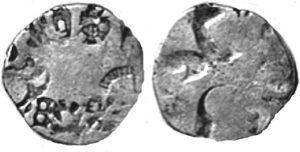
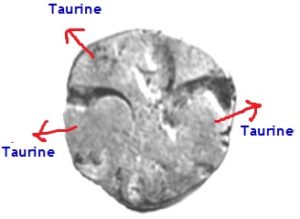
https://en.wikipedia.org/wiki/Nanda_Empire
Coins under Maurya rulers
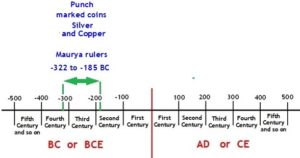
Since the last quarter of 4th century BC(BCE), the growing power of Maurya rulers over large parts of northern India was seen. The Maurya dynasty of Magadha was established by Chandragupta Maurya. Maurya dynasty of Magadha ruled between 322 and 185 BC(BCE). The capital city was Pataliputra which is present city of Patna. Under the Emperors of Maurya dynasty, especially Emperor Chandragupta Maurya and his successors several internal and external trade, agriculture, and economic activities etc thrived and expanded across South Asia due to the creation of a single and efficient system of finance which facilitated larger transactions of money by way of Coins. While one of the Kings in their dynasty, Chandragupta Maurya embraced Jainism another King Ashoka embraced Buddhism. During their period, large scale metallic money in the form of punched marked Silver and Copper Coins have been issued.
Punched marks mean specific design elements punched over the metal as if they were engraved. The Coins issued by them had few specific marks punched on them. All the Coins issued did not have the same marks on all of them. The marks were random on each Coins. Coins issued at later stages had the same marks plus few more fresh marks impressed along with old marks. The Mauryans Empire Coins maintained royal standard for their authenticity. Their Coins in various denominations were called as Karshapana. The Arthashastra, written by Kautilya mentions minting of bimetallic Coins in the regime of Mauryans.
As per Arthashastra, metals were melted, purified with some chemicals and then converted into sheets before minting them into Coins by punching few symbols. At some stage, the Mauryan Emperors continued issue of Coins with 5-punch marks in the Karshapana Coin series. In the Coins issued in the earlier period of Magadha rulers, several punch marks were seen on each Coins, but during the period of rule of the Mauryan Emperors of Magadha, standards for the shape and size of the Coins with fixed number of punch marks were laid out. Most of the Coins excavated belonging to the period of Mauryan Emperors were round in shape with rugged edges, not uniform in size, oval or square shaped with symbols punched on them.
Various symbols used as punch marks were Floral patterns, Hills, Birds, Animals, Reptiles, Human figures etc where particular symbol represented particular place or area. Mauryan Dynasty also introduced Silver punch marked Coins in the name of Pana, Ardha Pana, Ashta Bhaga and Ardha Padhika, each having lower and lower values in the order mentioned. The values were identified by their names and shape or size and metal.
The Coins were mixture of very small to bigger in size and were even circulated amongst those beyond Mauryan borders. Some of the Coins excavated weighed around 2 to 3 grams and called Mashaka. The various names attributed to the Coins, issue of smaller and bigger Coins in combination, issue of the lowest weighing Coins etc confirm for the second time that the value of each group of the metallic Coins issued had been laid down in clear terms and concept of money had already set in their period of rule.
Besides Mauryan rulers,the rulers of 7th century in Ancient Greece followed by Shishunaga rulers in 5th to 4th Century too have issued Coins with differential values by way of specific weight or no of mustard seeds per Coin though it was not followed by the succeeding rulers. However some of the Indo-Greek rulers at later period have issued differential valued Coins based on their weight of Red and Black Abrus precatorius seeds.
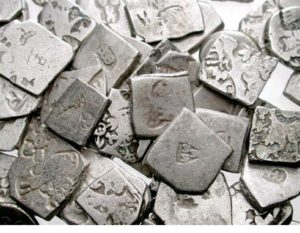
Mauryan Coins.
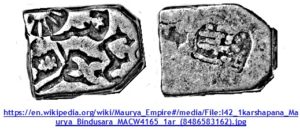
Coins in Shunga Dynasty
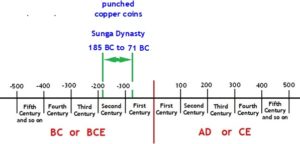
The Shunga dynasty was a brahmin dynasty established in 185 BC(BCE). Pushyamitra Shunga was the founder of Shunga dynasty. He was a military general with one of the Maurya rulers and ascended to power after killing his master Maurya king in a coup. The Hindu ruler Shunga Dynasty lasted only for a short period from 185 BC(BCE) to 71 BC(BCE) after the fall of Maurya Empire. There were four rulers in Shunga Dynasty and Devabhuti was the last ruler in them. The Shunga dynasty lasted for about one century and was then overthrown by the Brahman minister Vasudeva, who founded the Kanva dynasty in 73 BC(BCE). Their rule centered around present Malwa region in Madhya Pradesh.
The Shunga rulers have also issued non-uniform flat Copper Coins depicting the images of Animals and few other symbols like Arched Hill, Elephant, Taurine (Bull or Ox like animal), Swastika, Hollow Cross etc. The Copper Coins issued were smaller in size, about one square inch inscribed (punched) with four or five symbols on one side of the Coin and the other side remained blank and un punched. In some of the Coins one of the symbols was replaced by a legend showing the names of the ruler. Some of Copper Coins were also seen punched with only one or two symbols.
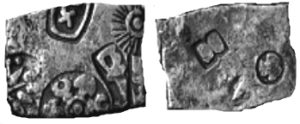
https://en.wikipedia.org/wiki/Pushyamitra_Shunga
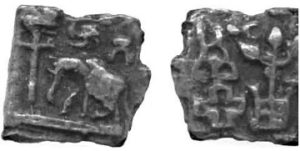
https://en.wikipedia.org/wiki/File:Shunga.JPG
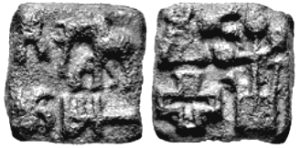
Attribution: Classical Numismatic Group, Inc. http://www.cngCoins.com
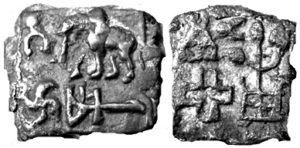
Some more Coins of Shunga dynasty
Before the emergence of Greco-Bactrian Kingdom, a short lived Kingdom in the name of Kanva dynasty which was established by Brahmins after the fall of Shunga dynasty lasted for less than forty to forty five years from 75 BC(BCE) to 30 BC(BCE) and did not issue Coins but continued to use the same Coins as issued by the Shunga dynasty rulers.
Coins in Greco-Bactrian Kingdom
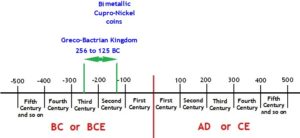
The Greco-Bactrian Kingdom was established covering easternmost part of the Hellenistic world that included Bactria and Sogdiana in Central Asia (on the north of present-day Afghanistan). Their dynasty ruled from 256 BC(BCE) to 125 BC(BCE). The rule of Greco-Bactrian Kingdom actually laid foundation for the establishment of later Indo-Greek Kingdom which ruled from 180 BC(BCE) to 160 BC(BCE). The most important King of Greco-Bactrian was King Diodotus who declared independence in around 250 BC(BCE) and proclaimed himself as King Diodotus-I of Bactria.
Before the collapse of Maurya Empire, the Coins in use were punch-marked Coins. With the fall of Maurya regime, punch marked Coins were replaced by Die cast Coins as introduced by Greco-Bactrian Kingdom besides minting bimetallic Coins made of Copper or Silver on which the images were punched with seals engraved with images.
After manufacturing sheet of Silver or Silver combined with other metals (alloy), Coins were cut out to proper weight, and then small punch-dies having images were pressed on them to form relief images on the surface of the Coins. In respect of other metallic Coins, the individual Coins were first cast by pouring a molten metal, usually Copper into a cavity formed by two moulds and while they were still hot, die-struck first on one side, and then die struck on the second side. Typically between 5 to 10 punch dies were impressed on one Coin.
The Greco-Bactrians were the first in the world to introduce and issue Bimetallic Cupro-Nickel Coins influenced by the bimetallic weapons made by the Chinese. These Coins were issued by Greco-Bactrian Kings namely Euthydemus, Euthydemus II, Agathocles and Pantaleon.
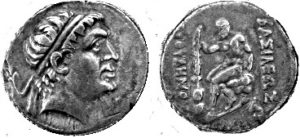
https://commons.wikimedia.org/wiki/File:EuthydemusMedailles.jpg
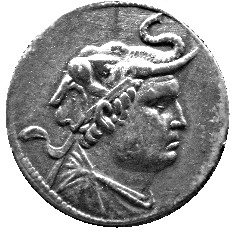
Courtesy : https://www.wikiwand.com/en/Demetrius_I_of_Bactria
Coins in Chedi Kingdom
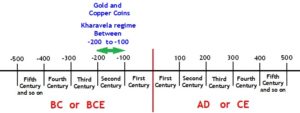
In ancient India many Kingdoms rose and fell. While some ruled for longer period, some of the Kingdoms had shorter stint. Similarly not all those who ruled have issued Coins. Some Kingdoms continued use of the Coins issued by the previous rulers, the others issued fresh Coins of their own. One such Kingdom which ruled in the 2nd Century BC(BCE) after the fall of Maurya rulers was called Chedi dynasty, also called as Maha Meghavahana dynasty by some scholars. They were one of the rulers of Janapadas. King Kharavela, the third rulers in Chedi Dynasty was the best-known king of the Maha Meghavahana (Chedi) dynasty and his works were known through Hathigumpha inscription found inscribed by the King himself in the cave in Udayagiri near Bhubaneswar in Odisha. Many Coins have been issued under his regime in the name Karshapana.
King Kharavela was follower of Jainism and he belonged to the third generation of Kalinga Chedi dynasty. He built the Great Victory palace in his capital called Kalinga Nagari after ascending the throne. The cost of construction of the palace was estimated to be a whopping 38000 Coins which confirm the findings of Archaeologists that both Copper and Gold Coins have been issued abundantly during his regime. The Coins were not round in shape but non uniform in shape.
Archaeologists generally attribute the period of Chedi dynasty’s Kharavela regime to 190 BC(BCE) to 170 BC(BCE) while some differing views attribute his dynasty to the period 200 BC(BCE) to 180 BC(BCE). According to Dr. Ashok Nath Parida, Reader in History of Utkal University who has studied the Economic life in Ancient Orissa {6th Century BC(BCE) to 4th Century A.D(CE)}, the Gold Coins issued were used for foreign trade and Copper Coins were issued to meet the needs of the common people for local transaction during the dynasty of Kharavela.
It was under him that Kalinga became a great power, with extensive territories as an empire. The ambitious public works undertaken by Kharavela might have increased the demand for coinage and that monetized the economy further. This confirms that the Coins issued in his rule had higher face value similar to the modern day money though the differential values of the metallic Coins issued remain unknown.
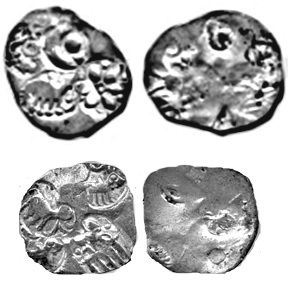
Some of the Coins of Chedi dynasty
Coins in Indo-Greek Kingdom
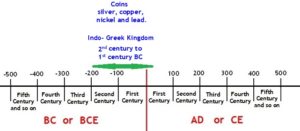
The History of the Indo-Greek Kingdom then locally known as Yavanarajya Kingdom covers the period from the 2nd century BC(BCE) to the beginning of the 1st century AD(CE) in northern and north western India. The Indo-Greek Kingdom is splinter group of Greeks which was established during the period of Hellenistic world. When the Greeks entered into Asiatic region they were divided as Greco-Bactrians and Indo-Greeks.
Over thirty Indo-Greek kings have ruled, often in competition on different territories. All the Coins issued during their period have been found to be impressed with the images of the Kings. Coins issued by them were mainly made of Silver, Copper, nickel and lead. The Coins issued by the Indo-Greek kings of north western India were found in large numbers in various places of modern Afghanistan, Pakistan, and India. Those Coins were significant because they carry detailed information about the issuing Monarch, the year of issue and sometimes even an image of the reigning King.
The finds of Indo-Greek Coins, particularly those belonging to the period of Appolodotus-I, an Indo-Greek king who ruled between 180 BC(BCE) and 160 BC(BCE) or as some other scholars say was between 174 and 165 BC(BCE), have been excavated along with Coins of Kuninda Kings who ruled from 2nd century BC to 2nd century AD(CE). This confirms that the format of modern day concept of money had taken further roots showing differential values of the Coins issued by way of different metallic Coins beginning from the highest valued metal like Gold to next lowest metal Silver to the next lowest metal Copper to the next lowest metal Nickel to the cheapest metal Lead. By the 1st century, coinage of Indo-Greek kingdom began to increasingly influence Coins from other regions in India. The historians say that it was Indo-Greek rulers who introduced for the first time in India the use of Gold Coins after which the Kushan rulers further consolidated its development.
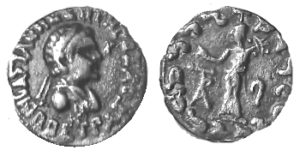
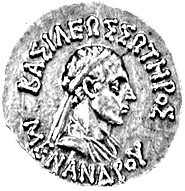
Courtesy:
https://en.wikipedia.org/wiki/History_of_the_Indo-Greek_Kingdom#/media/File:MenandrosCoin.jpg
Coins in Hellenistic Period
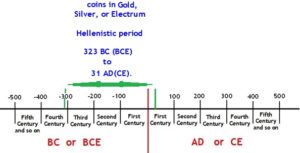
The Hellenistic period of rule covers the period between the death of Alexander the Great in 323 BC(BCE) and the emergence of the Roman Empire. After the death of Alexander, his five generals took over the Greek Kingdom and divided the country amongst them spreading the Greek culture in which they paid special attention to the issuance of Coins too. During Hellenistic period several Kingdoms ruled from 323 BC(BCE) to AD(CE) 31 besides Greco-Bactrians and Indo-Greek Kingdoms. The other Kingdoms during Hellenistic period include Kingdom of Egypt, Kingdom ofans who spoke Greek or identified with the Greeks.
In the Hellenistic period of coinage, the Coins were incused with the portrait of the King who held the Kingdom at that period. The portraits on the Coins reflected the true nature of the Hellenistic art by showing finer details of the features of the images impressed on the Coins. Greek Coins were among the most attractive ancient artifacts. However deviating from the Greek custom of punching the images of the Deities and Heroes on the coins, the rulers in Hellenistic period got the Coins impressed with the portraits of their own Emperors.
The archaeologists point out that all the Greek Coins were hand made by pressing the designs on both sides of the Coins with a die rather than machined as modern Coins are. Blank metal pieces in Gold, Silver, or Electrum were placed in between the male-female dies on which the design elements were carved and then hammered to impress the images engraved on them. Probably the same technique was also adapted by the other rulers in Hellenistic period.
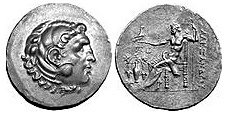
Few Coins issued by Hellenistic rulers
Coins of Seleucid dynasty in Hellenistic period
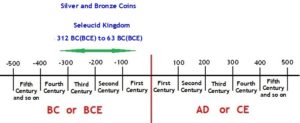
One of the important Kingdoms in the Hellenistic period was Seleucid Kingdom under Emperor Antiochus III the Great. The Seleucid dynasty consisting of more than 28 Emperors ruled from 312 BC(BCE) to 63 BC(BCE) when the Macedonian Empire vastly expanded earlier by Alexander the Great broke into divisions. The Seleucid Emperors lost their rule in the mid-2nd century BC(BCE).
The importance of Seleucid emperors is their coinage which followed the standards of Emperor Alexander, the great of ancient Greece, whose issue of Coins were based on Athenian coinage of the Attic weight. Attic weight, or the Attic standard, was a monetary standard used during the Hellenistic period. For a major period of time, the rulers in Hellenistic period continued to strike coins in the name of Alexander the Great because they were widely accepted in trade in those periods. After the death of Alexander, many of the Greek monetary standards followed by some of the rulers were abandoned in favor of the Attic standard. During the 300 years of the Hellenistic period, the Attic weight underwent several changes.
During the rule of Seleucid emperors, differential valued Bronze Coins have been issued varying in weight and size. The circulating coinage of the Seleucids was based on the Attic standard in which a Silver tetradrachm weighed 17.2 grams and a Gold Stater weighed 8.6 grams. Cities also issued lesser valued Coins in Bronze for local circulation. The Silver Coins issued by them were called Obol, Diobol, Hemidrachm, Drachm and Tetradrachm and each of those groups were impressed with separate symbols like Bow and Quiver, Anchor, Elephant and Bow and Anchor combined to identify them. The rulers used several mints for producing the Coins.

Selecuid Coins
Coins of Ptolemaic Kingdom in Hellenistic period
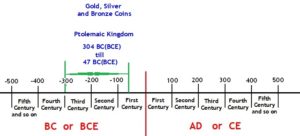
The next important dynasty which ruled during Hellenistic period was Ptolemaic Kingdom which was based in ancient Egypt. The Ptolemaic dynasty consisted of 17 rulers. They ruled from 304 BC(BCE) till 47 BC(BCE) and their dynasty ended with the death of Cleopatra VII Philopator who was the last ruler. The Ptolemaic Kingdom was founded in 303 BC by Ptolemy I Soter, a diadochus originally from Macedon in northern Greece who declared himself Pharaoh (the title held by the ancient Egyptian Kings) of Egypt and created a powerful Macedonian Greek dynasty.
The Kingdom of Ptolemaic issued extensive series of Coins in metals like Gold, Silver and Bronze. The rulers maintained Phoenician weight standard which was about 14.2 grams for the Coins issued by them. This standard, which was not used elsewhere in the Hellenistic world, was lesser than the Attic weight. The Attic weight was approximately 17.26 grams in silver. Consequentially, Ptolemaic coins were smaller than other Coins issued by other rulers in the Hellenistic period. Even after the fall of the territories held by the Ptolemaic rulers into the hands of the Roman Empire in the Hellenistic period, the Coins issued by the Ptolemaic dynasty continued to remain in circulation for long time.

Ptolemaic coins
https://en.wikipedia.org/wiki/Ptolemaic_coinage
Coins of Pontus Kingdom in Hellenistic period
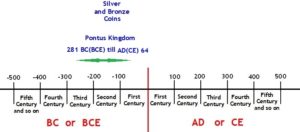
Another short lived Greek Kingdom in the Hellenistic period was the Kingdom of Pontus who ruled the southern coast of Black Sea which is in the present Turkey. They were referred as Pontik Greeks. There were 14 Kings in their Kingdom that ruled from 281 BC(BCE) till AD(CE) 64. In the period of few of their Kings, the issue of Coins have gained importance.
The Coins in Silver and Bronze issued by them show the burst or portraits of their emperors on one side of the Coins. The royal title in Greek or flying horse identified with Greeks, was inscribed on the back side. The important Emperors in whose rule the Coins have been issued were Pharnaces II of Pontus, also known as Pharnaces II, Mithridates IV of Pontus and Marcus Antonius Polemon Pythodoros also known as Polemon II of Pontus.
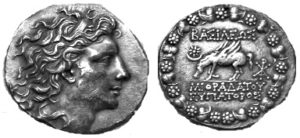
https://en.wikipedia.org/wiki/Coinage_of_the_Kingdom_of_Pontus
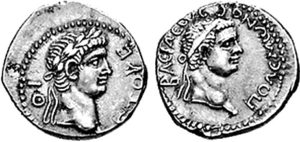
Attribution: Classical Numismatic Group, Inc. http://www.cngcoins.com
Coins in Yaudheyas Kingdom
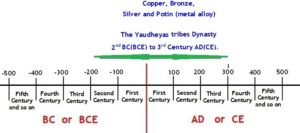
The Yaudheyas tribes were said to be decedents of Yudhishthira of Pandavas as referred in Mahabharata and Brihatsamhita Puranas. They ascended to power after the death of Menander-I, who was the king of Indo-Greek Kingdom by declaring independence in the middle of the second century BC(BCE) and ruled till 3rd century AD(CE). After the death of Pusyamitra Shunga, smaller rulers started moving south wards, probably under the pressure of Indo-Greeks and occupied the region of North of Saraswati river.
The details of the powerful clan of Yaudheyas who had a high social and political status came to light through the Coins discovered in large number in parts of Rajasthan, Punjab, parts of U.P and in Haryana. While most of the Coins issued by them were in Copper, they have also reportedly issued Coins in Bronze and Silver. The Coins issued by them carry the image of Lord Karthikeya also known as Brahmanyadeva with Peacock, the vehicle of Lord Karthikeya.
The Yaudheyas issued their earliest Coins in Copper, Bronze and Potin (which is an inexpensive metal alloy with combination of Copper, Tin and Lead) with the brahmi legend. Lord Karthikeya being the warrior god, he was given importance by punching his image on the Coins of Yaudheyas and also peacock is widely depicted alongside of him(vehicle of the war-god Lord Karthikeya).
Some of the symbols found inscribed on the Coins issued by them include Double Trident, Star, Sun, Triangle headed staff and legend in Brahmi reading Maharajasa, Inverted Trident etc. The other symbols found on Coins were Elephant, Bull before Sacrificial Kund, Lord Karthikeya with his consort Devasena, Multi branched Tree, Lord Shiva and Deer below a Temple etc.
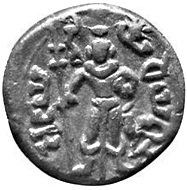 Coin of the Yaudheyas with depiction of Kumara Karthikeya
Coin of the Yaudheyas with depiction of Kumara Karthikeya
https://commons.wikimedia.org/wiki/File:YaudheyaCoin.jpg
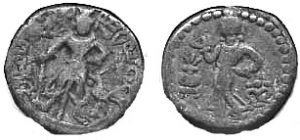
Some more Coins of Yaudheyas dynasty
Coins in the period of Roman Emperors
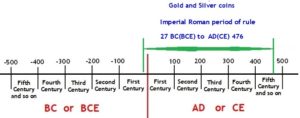
From 30 BC(BCE) onwards, the Roman Kingdom took over the reins of Greek world and the period began to be called Imperial Roman period i.e Modern Greek period. Roman Imperial Period was its last, beginning with the rise of Rome’s first emperor in 30 BC(BCE) and lasting until the fall of Rome in AD(CE) 476. During this period, Rome saw several decades of peace, prosperity, and expansion. By AD(CE) 117, the Roman Empire had extended their power to three continents including Asia Minor, northern Africa, and most of Europe though some western parts were still under the rule of Indo-Greek rulers. The first Roman emperor was Augustus Caesar.
With series of conflicts taking place by the mid 3rd to 4th Century, the Roman Empire got divided into East and West Roman empire. After Emperor Constantine took over the reign of west Roman lands, he became the last emperor of the unified Roman empire when their rule ended in AD(CE) 476. The Roman Emperors adored different titles throughout history. Emperor Constantine-I is often credited with converting the Roman Empire to Christianity. After unifying the Roman Empire under his rule in AD(CE) 324, Constantine rebuilt his seat of his power in largely Christian Byzantium, which was renamed Constantinople and today is Istanbul.
Under Roman rule, the Greek cities continued to produce their own Coins for several centuries. The Coins produced during this period were called Roman provincial Coins or Greek Imperial Coins. Roman provincial Coins were minted within the Roman Empire by local civic rather than imperial authorities. Most of the Coins initially used were same Coins that existed prior to the rule of the Romans and because many of them were minted in the Greek areas of the empire. They were referred to as Greek Imperial Coins.
At some point of time, both the Indo-Greek Kings and the Romans continued to issue the Coins in the areas under their control. Both Roman and Greek rulers had issued non-die cut, but almost round shaped metal pieces especially in Gold with some images (seals) impressed on both sides which according to the archaeologists were indeed Coins. Every month around ten shiploads of Gold Coins have been exchanged between Romans and Kushan Empire in trading activities which will speak the extent to which the Coins may have been produced in Imperial Roman period of rule. Many such Gold Coins issued by Romans have been excavated in India.
Few Archaeologists say that large quantities of Gold and Silver Coins struck by different Roman emperors, especially bearing the stamp of Augustus (who was a Roman statesman and military leader to become the first emperor of the Roman Empire, reigning from 27 BC(BCE) until his death in AD(CE)14) have been found in Tamilnadu to stand testimony to Indo-Roman trade.
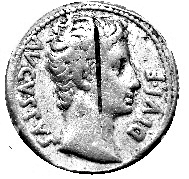
British Museum. Caption: AVGVSTVS DIVI F [ILIVS].
Attribution: I, PHGCOM
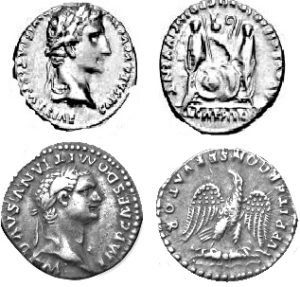
Few of Imperial Roman Coins
In the Imperial Roman period, the standard value of Tetradrachm (one of the Coins) was worth three Denarii (one of the Coins) and in some periods four when Roman Emperor Nero was in reign. The Tetradrachms were always over valued against the Denarii, and the rate of over or under value between them fluctuated in the periods of different rulers. In AD(CE) 60 or so, Emperor Nero standardized the Values of Tetradrachm Coins @ four Denarii and removed the under valuation of the Coins which was three Denarii per Tetradrachm.
The Silver Coin i.e Tetradrachm of Roman Syria was almost large, thick coins weighing 14 or 15 gms per Coin and the entire Silver Coins were produced from strictly controlled alloys of Silver and Copper from the mints of Antioch, Tyre and that the number of different standards in use at various other subsidiary mints were restricted and slowly changed to one standard. At one point of time the entire Syria had one standard Coin issued from two mints in Nero’s period of rule. Prior to the rule of Nero the Coin Denarii was more in use while in Nero’s time the issue and use of of Coin Tetradrachm was more. After merging the standards of Coinage to one, all the Coins in circulation of pre Nero period were withdrawn totally.
Coins in the period of Satavahana Dynasty
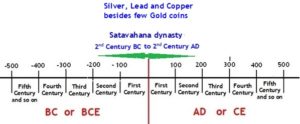
It will be interesting to know that two ruling dynasties – one in the north and the other in the south- ruled in the same period from 2nd Century BC(BCE) to 2nd Century AD(CE) have issued Coins in different manner. In south Deccan plateau, Satavahana dynasty established by King Simuka took over Deccan Plateau and extended the Kingdom up to some parts of present day Maharashtra after driving out Kings of Kanva dynasty. The genealogy of Satavahana kings are mentioned in some of the Puranas. Some of the Coins issued under their rule have been excavated in places like Nashik though the archaeologists feel that the Satavahanas belonged originally to the then state of Andhra region.
The Satavahanas have issued many Coins in Silver, Lead and Copper besides few Gold Coins which contain the images of the kings of Satavahana rulers impressed on them. The portraits show the facial features of the kings differently like King with curly hair, King with long ears and strong lips. The other design elements in their Coins include Animals and Stupas or Cross with Circles, Wheel with spokes, Bull with horns, Conch, Humans, Lotus, Moon, Ships, the Sun between two crescents.
The Coins issued by the rulers were also not uniform in size or shape. Most of the symbols on the Coins show that the rulers may have been very religious. The Coins of Satavahana Dynasty issued on various metals had different shapes and varying weights. The mould cast and die struck.
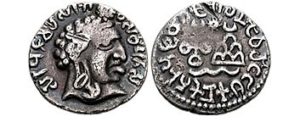
https://en.wikipedia.org/wiki/Satavahana_dynasty
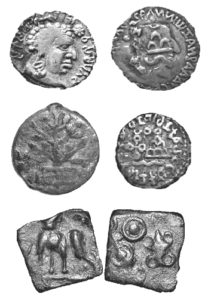
Some more Coins of Satavahana Kingdom
Coins in the period of Kuninda Kingdom
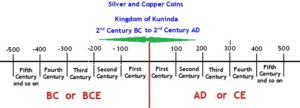
While Satavahana dynasty were ruling in Deccan Plateau, the Kingdom of Kuninda ruled the territories around Uttarakhand and southern parts of Himachal in the same period i.e from 2nd century BC(BCE) to the 2nd century AD(CE). One of the first kings of the Kuninda was Amoghbhuti, who ruled in the mountainous valley of the Yamuna and Sutlej rivers in the late 2nd century BC(BCE) to 1st century BC(BCE). He is well known for the beautiful Silver and Copper Coins issued during his regime. The Silver Coins issued by him followed the Silver standard of the Indo-Greek Coins.
The Kuninda Coins have been issued in two spells, the first one around the 1st century BC(BCE), and the second around the 2nd century AD(CE). The Coins of Kuninda, issued in the first period were influenced by the Coin models of Indo-Greek kingdoms, and incorporated Buddhist and Hindu symbols such as the Triratna and images of Lakshmi. The Triratna represents three Jewels of Buddha and symbol composed of a Lotus flower within a circle, a Diamond rod or Vajra and Ananda chakra.
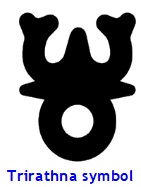
The finds of Kuninda Coins have often been associated with finds of Indo-Greek Coins, particularly those belonging to the period of King Appolodotus-I, who was an Indo-Greek king who ruled between 180 BCE and 160 BCE or between 174 and 165 BCE. Amongst the Kuninda Coins excavated, many were found to be in the name of king Amoghabhuti who was another king of the Kuninda Kingdom. Some of Coins issued in the second period were seen impressed with the image of Lord Shiva.The Silver and Copper Coins were uneven square shaped or rectangular in shape showing five symbols inscribed on them.
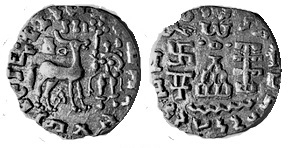
Courtesy: https://commons.wikimedia.org/wiki/File:KunindaCoin.JPG
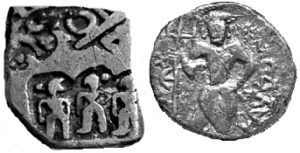
https://en.wikipedia.org/wiki/Kuninda_Kingdom#/media/File:Shiva_with_trident_Kuninda_2nd_century.jpg
Coins in the period of Kushan Kingdom
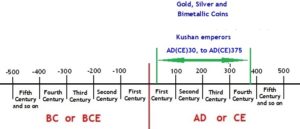
Kushan rulers have ruled for a period of about three centuries spanning from AD(CE) 30 to AD(CE)375. Kushans were one of the five confederations of Yuezhi Nomadic tribes and their territories included Afghanistan to northern India.
The Kushan Emperors have issued many Coins. Puri Kushan Coins are generally classified under two broad heads viz., the inscribed Coins and the uninscibed Coins. An inscription refers to anything engraved on a Coin. Whilst it is usually placed around the main design and follows the curve around the Coin, it can also feature on the edge of the Coin. The inscribed Coins have two standing Human figures on two sides. The symbol of a Crescent is found either on the reverse side of the Coin or on both the sides of the Coins. Some Coins without the Crescent sign were also issued. On the reverse side of some of the Coins there were three Pyramid shaped symbols seen with an inscription ‘Tanka’.
One of the most important Kings in Kushan dynasty has been King Kanishka-I, the great, who ruled from AD(CE)127–150. During the Kushan period, though several non-imaged Copper pieces issued were seen without impressed images on them, few of the Gold and Copper Coins discovered have been found with impressed images. The image impressed Coins belong to AD(CE) 30–375 period when Kushan rulers were on throne. The Coins weighed in different grammages suggesting that they may have been issued specifying the values of metallic Coins issued in the form of pieces. During the rule of Kushans, besides issue of Gold and Silver Coins, some of the Gold Coins excavated show the Coins debased with Silver indicating that they may have been bimetallic Coins. Many such Coins have been excavated from different parts of Orissa and Ranchi in the present state of Bihar.
The find of debased Coins suggest that the concept of bimetallic Coins may have re surfaced in their period. As one of the greatest ruler of the Kushan dynasty, Emperor Kanishka minted Coins during his reign which were distinct from the earlier Coins of other dynasties in a way that he was the first one to mint the Coins with the effigies of Buddha. Five Gold Coins of Kanishka earned the name rarest because only five Gold Coins with the portrait of Buddha have so far been excavated around the world. The legend on the Coins of King Kanishka show Iranian title ‘shaonana shao‘ meaning ‘King of Kings’ in Iranian legend instead of legend in Greek. On the reverse of the Coins series of Iranian and Indian Gods and Goddesses were seen incused.
The Kushan Dynasty came up with the revolution in the coinage of the country as they were the first to introduce Gold Coins with the images of rulers along with images of Deities. The emperors of the dynasty believed that they were ruling the subjects (people) because of God’s grace and hence impressed the images of Deities to show that only Divine bestowed them the power of seat. Prior to the origin of this type of Coins, punch marked Silver Coins with just fewer symbols sans images of rulers or Deities were seen. The Kushan Coins became very popular and the trend of showing the ruler on the front side of the Coins with the images of the Hindu deities on the reverse side was followed by succeeding dynasties in the next six centuries.
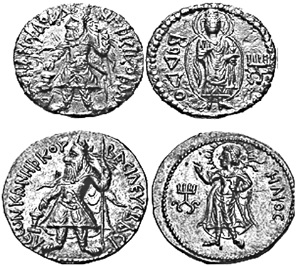
Courtesy: – http://en.wikipedia.org/wiki/kanishka
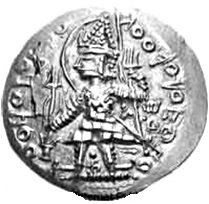
One more Coin of Kushans
Coins in the period of Naga Kingdom
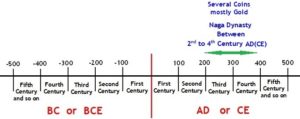
The Naga dynasty consisting of nine rulers ruled at different periods, parts of north-central India during the 3rd and the 4th centuries AD(CE), after the decline of the Kushan Empire but before the rise of the Gupta Empires. Their capital was located at Padmavati, the present city of Pawaya which is in the state of Madhya Pradesh. The Naga dynasty is known mainly from the Coins issued by their rulers.
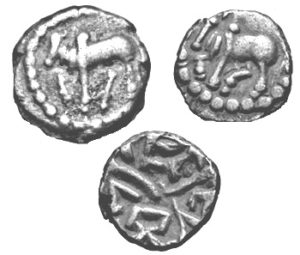
Naga Dynasty Coins
Most of the Kings in Naga Kingdom have issued Coins. One of the Emperor in Naga clan who ruled in early 4th century reportedly donated Gold Coins to various monasteries which confirm that Gold Coins have been in use as money during their period of rule. While the archaeologists claim that nine Naga rulers were there, the Coins of their period excavated in places like Bhind, Shivapuri, Morena, Jhansi etc in Madhya Pradesh suggest that there were thirteen different Naga Kings thus raising doubt whether there were really thirteen Naga Kings who ruled the area or only nine Kings adored their Kingdom. Since the entire aspects of the origin and rule of Nagas are not fully available, such doubts always remain.
The richest collection of Coins, which are smaller in size reveal the name of the Naga Kings with inscribed symbols like Rayed Sun, Peacock, Bull in standing posture, Squatting Bull, Trident, Shiva Ling etc. They are reportedly kept in Gwalior archeological Museum.
Coins in the period of Gupta Kingdom
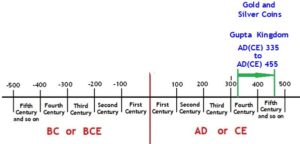
The Gupta Empire was an ancient Indian empire who ruled from AD(CE) 335 to AD(CE) 455. Few prominent Kings in them include Chandra Gupta, Rama Gupta, Kumara Gupta, Skanda Gupta and Vikramaditya. The coinage of the Gupta Empires who overthrew the Kushans and assumed power is not very different since the Coins issued by the Gupta rulers resembled to that of Coins of Kushan Empire in many respects such as weight standard, appearance and designs. The Coins issued were also not evenly shaped and had rough finished edges. The engraved designs on the Coins issued in their period reflected images of Valor, Deities and Martial arts.
Surprisingly it has also come to light that the Cowries have been simultaneously used as Money for trading in their Kingdom. During the reign of Chandragupta and Samudragupta who kept north India politically united for more than a century, i.e. from AD(CE) 335 to AD(CE) 455, large no of metallic Coins mainly that of Gold and Silver followed by Copper have been issued as the Kingdom had large treasure of Gold. In the history of India, the period of Gupta rule was viewed as Golden age due to the prosperity of the state seen under their rule. It is generally accepted that the organized format of Money had entrenched during the period of Gupta regime.
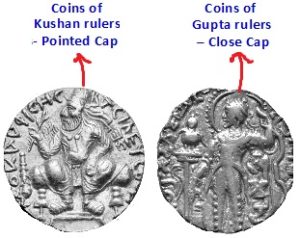
Samudragupta was the first ruler who reportedly minted Coins, but they were in imitation of the coinage of the Kushan Empire. The two type of Coins –that of Gupta rulers and Kushan rulers- were similar, except in the design element in which the headdress of the Gupta ruler showed close-fitting cap while the headdress of the ruler on Kushan Coins showed pointed hat. Similarly the Guptas maintained Garuda standard instead of the Trident standard as maintained by Kushans in the images cast on the Coins. The Gold Coins of the Guptas were known as Dinaras. The writings on those Coins were in Sanskrit and depicted the reigning monarch in different poses.
In some of the Coins issued during the rule of Guptas, the images embedded on the Coins show the King holding Arrow, Axe or Bow in Hand, Garuda in hand, Horse, King riding on Horse, probably a Deity sitting on a Wheel or Female before Peacock etc.
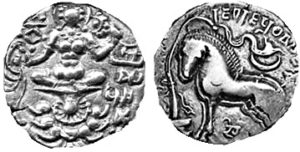
Coin of Samudragupta, with Garuda pillar, emblem of Gupta Empire
Attribution: I, PHGCOM
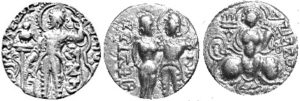
Some of the Coins in Gupta period
First Coins of the Gupta Dynasty were minted by Samudragupta who is considered the father of Gupta monetary system. The first Coins minted by him were called Dinara inspired by the Roman Coins but later the Coins were minted in Indian style with the weight standard of 9.2 gms of Gold and called Suvarna. Samudragupta minted eight distinct types of Coins showing Archer, Battle Axe (refers to his military activities), Chandragupta-I, Kacha, Tiger, Lyricist and Asvamedha type (commemorating the horse sacrifice ceremony). Those Coins threw lot of details about the Gupta Dynasty and their economy.
Later on entire successors of the dynasty minted similar type of Gold Coins which depicted their technical and sculptural excellence. Almost all the Coins showed a King engaged in some act displaying his royal status and heroism and few others showed a King standing and making oblations before an alter. Goddess Lakshmi seated on a throne was on the reverse of the Coins with Sanskrit legends. The Coins issued were in Gold, Silver and on Copper.
During war with Kidarite rulers the stock of Gold considerably dwindled with Gupta rulers due to which one of the Gupta Emperors Skandagupta had to considerably reduce minting of Gold Coins in his period of rule. This led to the disappearance of Coins of Gupta period in the western regions of India and Pakistan.
Coins in the period of Indo-Sasanian Kingdom
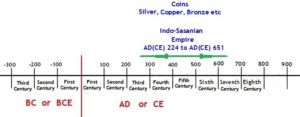
Indo-Sasanian, sometimes known as Empire of Iranians or Neo Persians ruled parts of Central Asia extending up to border of Peshawar in Pakistan after the fall of Kushan rulers. They self-titled themselves as Kushanshas meaning Kings of Kushans. The Sasanian dynasty was founded by Ardashir-I. The Sasanian Empire was the last pre-Islamic Persian Empire which ruled from AD(CE) 224 to AD(CE) 651 when it was overthrown by the Arab Caliphate.
The Coins issued by them have been minted in few places in Afghanistan and Iran. Coins depicting Shiva and the Nandi bull in their period have been discovered, indicating a strong influence of Shaivite Hinduism during the period of those rulers. The legend in their Coins were either in Iranian or in Brahmi language. The Coins issued by them threw light on nearly thirty plus Kings in their dynasty. The archaeologists are of the view that the Sasanian Coins were hand struck and not molded. A typical technical feature of Sasanian Silver Coins is that they were thinner and broader.
The Coins were issued in various denominations. The weight of the Coins and the property of metal like Silver, Copper and Bronze etc were the factors that determined the value of those Coins. Only very small quantity of Gold Coins have been issued and they were also not meant for public transactions. One side of the Coins had the portrait of the Kings while the other side had other elements such as Zoroastrian fire, Astral symbols, Star, Crescent, Cock’s head and Cross etc.
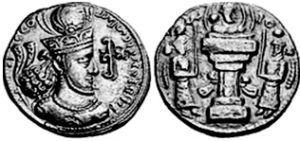
https://en.wikipedia.org/wiki/Sasanian_coinage_of_Sindh
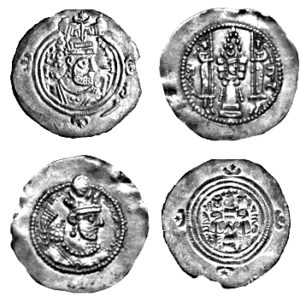
Some of the Coins of Sasanian Kingdom
Another interesting period in the Indian coinage was the emergence of large no of smaller states in northern India ruled by different dynasties after the fall of Gupta and Indo-Greek rulers which continued the issue of metallic Coins. However there was decline in the issue of Coins compared to the previous regimes because of decline in the trading activities on account of frequent invasions. Punched mark Coins made of Copper, Silver and Gold based on the weight system of Abrus precatorius seeds have been issued in those periods and Coins have been called in the names like Nishka, Karshapana, Satamana, Vimshatika.
Coins in the period of Kidara Kingdom
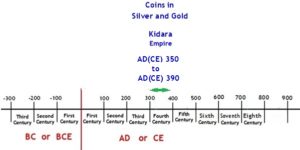
During the period AD(CE) 251 to AD(CE) 650 when Maurya Gupta dynasty and Indo Sasanian emperors were ruling some branches of Sogdiana, Kushan emperors and few tribal Kings were ruling Bactria and adjoining parts of Central Asia and South Asia. Almost during the same period two more dynasties namely Kidaras and Hepthalites ruled some parts of Afghanistan and Central Asiatic region. The Kidaras, who were also tribes, took over parts of Sogdiana after throwing away the Kushan emperor and Indo-Sasanian rulers from few parts of Central Asia. Kidara-I was the first king who established Kidara Kingdom in AD(CE) 350 .
Some historians point out that Kidaras were a branch of Kushans who initially established their Kingdom in Afghanistan and then came to India to capture lands in south Rajasthan and parts of Gujarat to extend their rule. Though they were initially Yuezhi tribes, they claim that they were decedents of Kushans. The Kidaras ruled from AD(CE) 350 to AD(CE) 390.
In spite of change of ruling dynasties in various period of time, the issue of Coinage did not stop. Under Kidaras, Coins named Kidarite were issued in Silver and Gold. Their Coins depicted clean shaven images of the Kings or Emperors. Some of the Coins depicted images of Fire Attendants wearing long suit with tight sleeves. The archaeologists say that the Coins of the Kidaras closely resembled to that of Kushan coinage because the Kidara rulers had adapted many elements of the design factors from Kushan and Indo-Sasanian rulers.
The first opinion on the design elements of the Coins of Kidaras have been given by Sir Alexander Cunningham who was a British army official who later took an interest in the history and archaeology of India. Besides Sir Alexander Cunningham, some of the chronicles of Chinese have also thrown light on the Coins of Kidara whose dynasty short lived. It was Cunningham who asserted that the Kidara Coins issued in Silver and Gold were inscribed with Brahmi script with the name of Kidara.
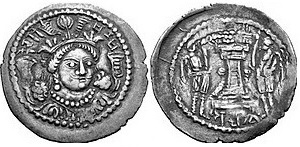
http://en.wikipedia.org/wiki/kidarites

Attribution: Classical Numismatic Group, Inc. http://www.cngcoins.com
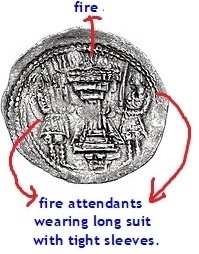
Coins in the period of Hepthalites Kingdom
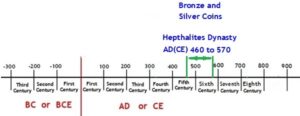
As said earlier, during the same period of AD(CE) 251 to AD(CE) 650 when Maurya Gupta dynasty and Indo Sasanian emperors were ruling, in some branches of Sogdiana, few tribal Kings from the dynasties of Kidara and Hepthalites were also ruling Bactria and adjoining parts of Central Asia and South Asia. The Hepthalites, also called White Huns, who were based in Bactria expanded their Kingdom to parts of Sogdiana, Afghanistan and Northern India after driving away both the Kidaras and Persians and ruled from AD(CE) 460 to AD(CE) 570.
During the period of their rule, Coins in Bronze and Silver were issued. Each nomadic tribes who were invaders of Europe, Middle East and Central Asia had their own symbols or seals for their group which were called Tamghas. Some of the Coins issued during Hepthalites period had signature of the ruler in Sogdiana language and their own Tamghas.
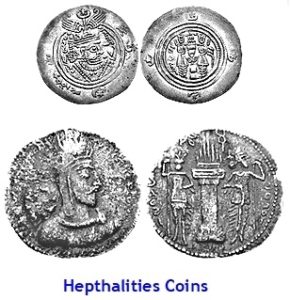
Attribution: Classical Numismatic Group, Inc. http://www.cngcoins.com
Coins in the period of Chera Kingdom in south
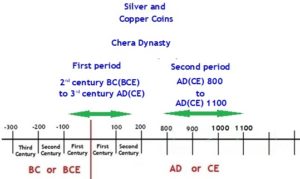
The Chera Dynasty was one of the three major Kingdoms in South India and ruled over the present-day state of Kerala and to a lesser extent, parts of Tamil Nadu. Though the exact period of Chera rulers are sketchy, from the historical records available, the Chera dynasty has reportedly ruled in two periods. One was the Sangam age and the other later. The Sangam period was 2nd century BC(BCE) to 3rd century AD(CE). The period of the Chera dynasty in the first period is not known though it is certain that their first King was Uthiyan Cheralathan. In respect of their second period of rule, they have reigned from AD(CE) 800 to AD(CE) 1100. Coins have also been issued in their rule.
The Coins issued during the Chera rule throw some light on them. Many Coins issued during the periods of Chera rule were discovered in Amravati river bed which is the longest tributary of Kaveri River running in Karur in Tamilnadu besides a place called Pattanam in Kerala. Pattanam is 25 KM from Kochi which is in Ernakulum district of Kerala.
The Coins, both in Silver and Copper issued by them were also punched mark Coins, square in shape, most of the inscriptions showing symbols like Bow and an Arrow, which was the symbol of Chera rulers. Their Coins have been punched in a Brass die which has also been discovered. Certain Coins were inscribed with portraits of rulers similar to Roman coins. Some of the Coins were punched only on one side while the other side was left blank.
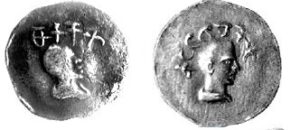
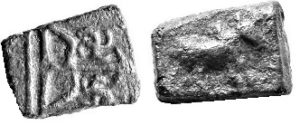
Courtesy: https://en.wikipedia.org/wiki/Chera_dynasty
Coins in the period of Pallava Kingdom in south
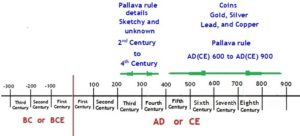
Like other dynasties, the Pallava dynasty has also reportedly ruled in two phases. They assumed power after defeating Satavahanas and then the same Pallavas were defeated by Chola Kings much later. The Pallavas initially ruled Thondamandalam touching two state boundaries. Thondamandalam is the northern part of Tamilnadu and southern part of Andhra Pradesh though their capital was Kanchipuram in Tamilnadu. At some point of time, the Pallava Kings had even extended their rule to Sri Lanka after annexing many parts in that country. While the initial period or emergence of Pallava rulers remains obscure, the historians say that the rule of Pallava began in 2nd century and lasted till 9th century AD(CE). But the details of their rulers were somewhat available only from AD(CE) 436–460 though everyone uniformly admit that the Pallava dynasty has been established by a King called Simha Vishnu. Their second period of rule was probably from AD(CE) 600 to AD(CE) 900. This means at some period of time different dynasties ruled different areas adjacent to them with common economic programes. This is one of the reasons why the Coins of one dynasty has been found in use in places of different other adjoining dynasty with slight modifications in design elements and values .
Coins have been issued during the rule of Pallava by minting them in Lead, Copper and Bronze even though some historians are firm that Coins in Silver and Gold have also been minted. The reason attributed to their view is because of the fact that the Pallava Kings had distributed Gold Coins in the form of pieces during the Yagna conducted. While majority of the Coins issued by Pallavas were round in shape, the symbols on them included Bull, Lion, Swastika, Chakra (Few focal points in the human body connected to meditation practices), Flag, Ship with twin mast, Elephant, Crescent etc. Archaeologist say that the early Coins of Pallavas resembled to that of Satavahana Coins.
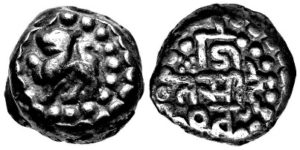
Coin of the Pallavas of Coromandel, king Narasimhavarman I. (630-668 AD).
Obv Lion left Rev Name of Narasimhavarman with solar and lunar symbols around
https://en.wikipedia.org/wiki/File:Pallavas_of_Coromandel.jpg
Coins in the period of Chola Kingdom in south
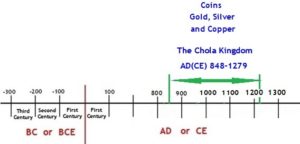
The Chola Kingdom one of the longest ruling dynasties in southern India was an ancient Kingdom whose some of the rulers were ruling smaller parts of South India in 2nd century BC(BCE) onwards. Cholas were mentioned in Emperor Ashoka Edicts of 3rd Century BC(BCE) as one of the neighboring countries which existed in the South.
The frequent attacks of Pallava, Chera and Pandiya Kings when receded, the Chola Kings assumed power in the 8th century AD. However making truce with the Chera Kings, the Chola Kings governed vast territory efficiently. The Chola dynasty however fell from power in AD(CE) 1279 .
An alliance between the Chola Kings and Chera Kings is evident from Coins discovered which bear the symbol of Tiger on the obverse and the symbol of Chera Bow and Arrow on the reverse. Coins with Goddess Lakshmi, of possible Sri Lankan origin have also been discovered from Karur river beds. The Chola Kings have issued many Coins during their rule based on which, the archaeologists opine that the coinage in the regime of one of the Chola Kings Rajaraja Chola was the finest one.
Two types of Coins issued during his period of rule are well known. One type of Coin show Bow-Tiger-Fish emblem on both sides and the legend Sri Rajaraja written beneath in Nagari characters. In the second type of Coins, while the image of a Man standing is displayed on the obverse, some one seated is seen on the reverse side with the Nagari legend Sri Rajaraja. Both type of Coins were in Gold, Silver and Copper and the mention of Rajaraja in those Coins indicate that they may have been issued in the period of Rajaraja Chola. Similarly the mention of Rajadhiraja in some of the Gold and Silver Coins suggest that they may have been issued during the rule of Rajadhiraja Chola who came to power several years later to Rajaraja Chola.
It has also come to light that during rule of Rajaraja Chola, the then Lanka was overrun by him from where he minted Coins as well. The design elements on them varied with the Coins issued by the same ruler from South India. The three important Chola emperors were Raja Raja the Great, his son Rajendra and Rajendra Kulothunga-I. There are various types of Coins of Raja Raja, the most common of which was the standing King on one side and a seated Goddess on the other.
The legend on most of the Coins were in Sanskrit. Rajendra Chola’s Coins have the legend ‘Sri Rajendra’ or ‘Gangaikonda Chola’ impressed with the images of Tiger and Fish. The Coins on which the images of standing King and seated Goddess were seen belonged to the period of Kulottunga-I suggesting that he may have issued them. There were other Coins which have the image of Tiger in the center, and Fish and Bow (the emblems of the Pandyas and Cheras respectively) on either side. On the margin was the legend ‘Kataikonda Chola’ or ‘Malainadu konda Chola’, each letter of which were seen punched separately.
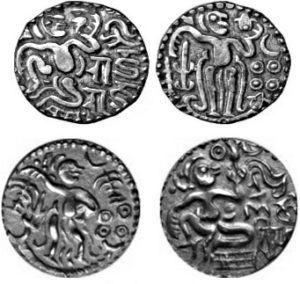
Courtesy: https://ancient-indian-coins.blogspot.com/2015/10/the-chola-their-coinage.html
Coins in the period of Pandya Kingdom in south
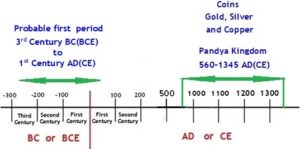
The Pandya rulers, one amongst the three great rulers -Chera, Chola, Pandya- of South India, initially occupied parts of Tirunelveli, present Ramnad district and Madurai in Tamil Nadu and ruled some part of the then Lanka too after waging war with Lankan rulers. Madurai was their capital. The Pandya rulers too have dominated in two periods of time with a gap. According to some scholars they had probably ruled from 3rd Century BC(BCE) to 1st Century AD(CE) in the first stint which has no definite corroborative evidence except mention of Pandiyas in the edicts of Emperor Ashoka and Greco-Roman sources when they had ruled during 3rd Century BC(BCE). The second stint of Pandiya rule was from AD(CE) 560 to AD(CE) 1345 as seen in the historical evidences available.
During their rule, the Pandiya Kings have also issued many Coins and donated few Gold Coins to temples too. The Coins issued under different rulers varied. The legends on some of the Coins were in Brahmi and in some Tamil language. Copper, Silver and Gold Coins of Pandiyas were punched mark Coins impressed with symbols like Fishes, Elephant, Boar with inscription Veera Pandiya. Other symbols on the Coins were Garuda, Nandi Bull, Pair of Feet etc showing the legend of various Pandya rulers. Their Coins were basically square in shape. The Coins were probably called Kalanju. The earliest Coins issued in the period of Pandyas were square, but die-struck, with an image of elephant on one side while the other side remained blank. The Coins issued between the 7th and 10th centuries by the Pandya Kings showed symbol of Fish. The Fish sometimes appeared in single and sometimes in pair. Also the Fish was seen in conjunction with other symbols like Chola King in standing posture or the Boar. The inscription on the Silver and Gold coins were in Sanskrit and most of their Copper Coins had Tamil legends.
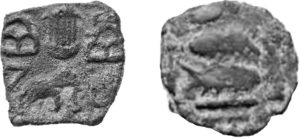
https://en.wikipedia.org/wiki/Pandya_dynasty
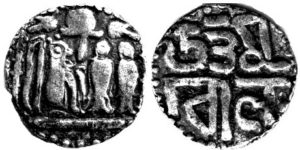
https://en.wikipedia.org/wiki/Flag_of_Pandya#/media/File:Chola_coin_with_legend_%22Uttama%22.png
Coins issued by Kadamba Kings
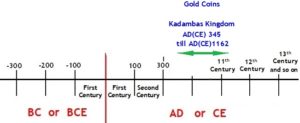
A Brahman ruler Mayurasharma, a scholar in Kannada established the Kadamba dynasty. Four different families of Kadambas ruled in southern India. They were Kadambas of Hangal, Kadambas of Goa, Kadambas of Belur and Kadambas of Banvasi. Kadamba dynasty was founded by Mayurasharma in AD(CE) 345. Their ancestors were said to have migrated from the foothills of the Himalayas. Kadambas allies Chalukya of Banavasi ruled during AD(CE) 345 to AD(CE) 566. The Kadambas ruled Goa and South Konkan as the feudatories of the Chalukyas of Kalyani to begin with from AD(CE) 973 to AD(CE) 1162.
During the regime of Kadambas, very heavy and purest Gold Coins have been issued which were of two types. One type of Gold Coins were Punch-marked Gold Coins and the other was Die struck Gold Coins.
The punched marked Coins had the image of Lord Hanuman besides image of Goddess Lakshmi in some Coins. The Die struck Coins had the images of Lord Hanuman inside dotted circle, Conch and Cowries. The other symbols or images were Sun and Moon Lords. Under Jayakeshi II, who was one of the Kadamba Kings, Gold coins stamped with their Lion crest have been issued.
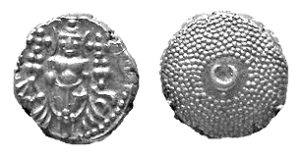
Courtesy:- https://en.wikipedia.org/wiki/Pagoda_(coin)
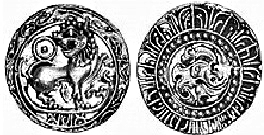
Coins of Kadambas
https://en.wikipedia.org/wiki/Kadambas_of_Hangal
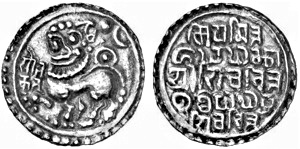
Kadamba Kings coins in goa
https://en.wikipedia.org/wiki/Kadambas_of_Goa
Coins of Chalukya Kingdom
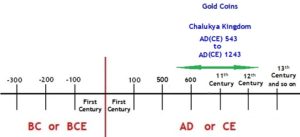
The Chalukya Dynasty was one of the powerful dynasties that ruled certain parts of South and Central India particularly that of Karnataka. There were four lines of Chalukya Kings who were cousins. The Chalukyas ruled from AD(CE) 543 till AD(CE) 1243. The Chalukya dynasty which extended their rule to the entire areas of Deccan plateau was established by Pulakeshin-I in AD(CE) 543. Pulakeshin-I took present place of Badami in Karnataka under his control and made it his capital. Pulakeshin-I and his descendants are referred to as Chalukyas of Badami.
In south, the coinage was reintroduced by the Chalukyas of Badami after a brief lull in the issuance of Coins due to instability in region created by the invasion of Pallava Kings. During their rule, since Gold was available in plenty in mines and shortage of Copper and Silver were there, the historians opine that issue of Gold Coins may have been higher compared to Silver and Copper Coins. A four gm weighing Coin was adapted as the standard, and the Coin was called as Huns, which was also called by some as Pagodas in some Kingdom. The factions of Hun was called Fanam. Since the trading from South to the Northern areas were high during those period, more Coins were released for transaction and trading purpose.
Animals specially the Bore were revered during their rule and hence the Coins issued by them had the images of Bore (symbolizing the face of Lord Varaha murthy). The other symbols on their Coins were Temple, Spearhead, Sceptre (ornamental Silver or Gold rod or stick used by Kings) between Two Lamps, Titles of the Kings, Lion, Sun, Lotus top, Garuda with a long beak, and Moon. The Coins issued by the western Chalukya Kings were punch marked Gold Coins in the name of Pagodas which were large but thinner Coins. The Coins were seen with more than one punch mark incused on them.
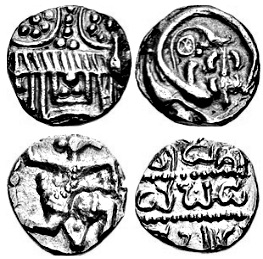
https://en.wikipedia.org/wiki/Western_Chalukya_Empire
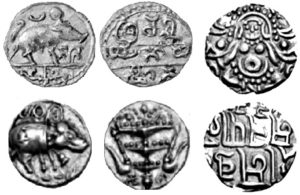
Some of the Coins issued during Chalukya period
Coins of Hoysala Kings
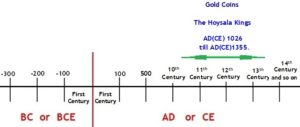
The Hoysala Kings too have issued some Coins when they were ruling Karnataka. They were in rule from AD(CE) 1026 till AD(CE) 1355. By 13th century, they governed most parts of Karnataka, minor parts of Tamil Nadu and parts of western Andhra Pradesh and Telangana in the Deccan Plateau. Hoysalas issued varieties of Gold Coins in the name of Pagodas. The symbols in their Coins included Elephant, Lion, Legend of the King, Goddess Chamundi, Winged Garuda, Lord Hanuman etc. Coins weighing 37 gm were issued in the name of Fanams.
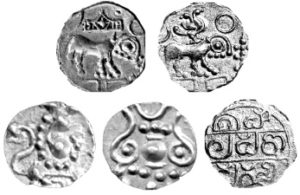
Suryavamsi Gajapathi Kingdom – metallic Coins and Cowries
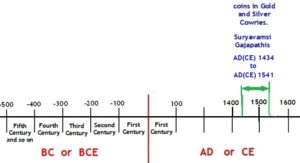
It is seen from the inscriptions available in Puri Jagannath Temple, several Cowries have been gifted to the temple during the rule of Suryavamsi Gajapathis, a medieval Hindu dynasty, who ruled most of the present day Odisha and Northern coastal Andhra in 15th and 16th Centuries {AD(CE) 1434 to1541}. During his regime he has issued several Coins in Gold and Silver, but what value each of the Coins carried is unknown since value per specific weight of each metal has not been made known. However the issue of Coins show that the general concept of metallic money had certainly set in some form. Even as the metallic pieces of Gold and Silver have been gifted or issued as pieces of Coins for transacting businesses or for purchase of goods during the rule of different dynasties prior to the rule of Gajapathis, how did the Coins reach the hands of public who transacted business with those metallic pieces or how were their values fixed against goods exchanged etc remain elusive. All that one knew was that pieces of Gold or Silver or other metals were in circulation amongst the public, and those metallic pieces were exchanged for any other goods they needed.
At the same time, the Barter system also co-existed simultaneously for transacting goods with goods. The Cowries and Shells were exchanged by the general public for any goods including for exchange of human slaves, since the Cowries and Shells were viewed precious material next to the metals. However how were the metallic Coins valued against other items, what were the individual measured unit values of them etc could not be ascertained. Also whether they were issued on mass scale as remuneration or salary for the work done or gifts for specific purposes to the public against something transacted or performed is also unknown because the Coins with some seals were issued only by the rulers and not allowed to be manufactured by the public themselves. All that one know is that the metallic Coins and the Cowries – both as commodity money- may have been in use for transacting the business during the dynasty of Gajapathis, the medieval Hindu dynasty.
Coins of Rajput Kingdom
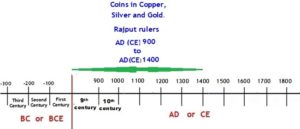
Rajputs comprise people from a variety of ethnic and geographical backgrounds and ideologically they are great warriors. They have played a significant role in many regions of central and northern India when they were in power. Their presence were felt from AD(CE) 900 to AD(CE) 1400 when several Rajput rulers ruled various regions.
Not much details are available on their coinage, however some rulers of Rajput clan have issued several Coins in Copper, Silver and Gold. Some of their Coins depict the images of Goddess Lakshmi. The Goddess was shown with four arms contrary to the two arms images of Goddess Lakshmi as seen on the Coins issued during the rule of Guptas. The other symbols found on the Coins issued by Rajput rulers included seated Bull(like Nandi), Horse rider and Female in seated posture etc.
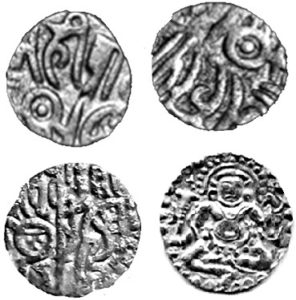
Some of the Coins issued by rulers of Rajput
Coins of Delhi Sultanates
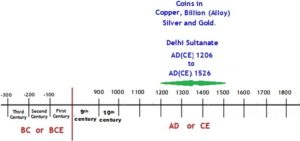
Between AD(CE) 1206 and AD(CE) 1526 five dynasties of Delhi Sultanates have ruled northern India. They were called Slave dynasty, Khilji dynasty, Tughlaq dynasty, Sayyad dynasty and Lodi dynasty. The Delhi Sultanates defeated Rajputs and captured power to rule for nearly 300 years covering most of north Indian states including areas in Bengal.
Coins were struck for the first time by the Sultanate in the name of Shams ud-Din Iltutmish al Sultan who was stated to be the founder of Delhi Sultanate. The sultanates reportedly issued Coins in the name of Tanka and Masha in metals such as Gold, Silver, Billion (Silver plus Copper Alloy) and Copper. The values of the Coins Tanka and Masha were different commensurate to their weight. Many of the Coins issued by them bore their names in one way or the other. Their Coins indicated various names and issued in different sizes suggesting that different valued Coins may have been issued in their regime. The Coins have been minted in cities like Sultanpur, Alwar and Delhi.
In later period of their rule, Coins in different shapes and sizes have been produced which however lacked perfection in design elements and finish. One of the rulers had issued Coins in Bronze and Copper equating their value to that of Gold and Silver. This confirm that the Coins lost their face value as the coffers of the ruler had dried out leading to financial crisis. Even some tokens have been issued as money. Those acts lead to lots of counterfeiting of Coins and the first known case of forgery in the money system began to surface in the regimes of Delhi Sultanate rulers.
In the Coins issued under different Delhi Sultanate’s period, the symbols inscribed on the Coins were mainly Star, Horse, Bull, Horseman, some kind of Square and probably names or titles of the rulers in some language. Not all the rulers issued Coins in the same metal. Some have issued in Gold, while some in Silver and most others in Copper or Bronze.
In the regime of one of the Sultanate Emperors namely Md Bin Thuklak, even Leather Coins have been reportedly issued in view of severe financial crisis faced by him.
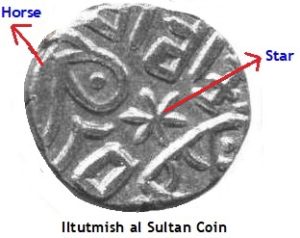
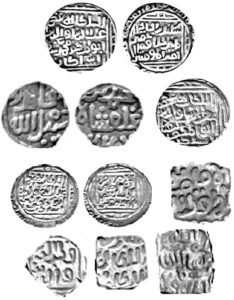
Courtesy:- http://www.chiefaCoins.com/Database/Countries/Sultanate_of_Delhi.htm
Coins of Vijayanagara Kingdom
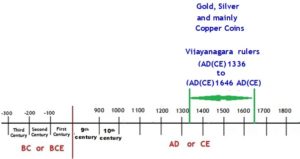
Vijayanagara empire was established by King Harihara in the year AD(CE)1336 on the banks of river Thungabadra in Deccan Plateau mainly in and around Karnataka close to Andhra Pradesh. The rule of Vijayanagara emperors lasted till AD(CE) 1646. Their rule thus lasted for three centuries.
In respect of Coinage, the rulers of their dynasty have issued many Coins in Gold, Silver and Copper. Their Coins mention the place of mint where they were produced. Though the initial group of Coins issued by them were inscribed with Lord Shiva and Goddess Parvathi, the later period Coins of their rule were inscribed with Vaishnavite deities. Their Coins clearly carried various values for payment system. While the first ruler in their dynasty Harihara issued Coins showing the images of Lord Hanuman and Garuda with captions like Sri Veera Harihara, the Coins of another ruler Veera Bukka were seen inscribed with Sree Veera Bukka Paraya. This indicate that the Coins issued by different rulers in their dynasty carried the name of their Kings.
Most of the Copper Coins issued in their rule carried images of Lord Shiva, Lord Hanuman, Goddess Parvathi, Goddess Lakshmi, Goddess Saraswathi with Lord Brahma, Lord Rama, Nandi, Sun, Moon, King fighting with wild Tusker, Bull with sword, and Conch etc. The famous King in their dynasty Krishnadevaraya has issued Gold Coins inscribed with Lord Varahamurthy, Nandi, Conch with Discus, Goddess Durga besides Lord Shiva and Goddess Parvathi.
While Gold Coins were not meant for day to day transaction, the Coins made out of Copper in the names of Pana or Kasu have been widely used in day to day transactions. However with the invasion of the Turks in 11th and 12th century AD(CE), vast areas of northern India came under the rule of the Muslim rulers and the trend in the decline of Coinage was revived by the Muslim dynasties who issued many Silver and Copper Coins inscribed in Perso-Arabic script without carrying the images of any one.
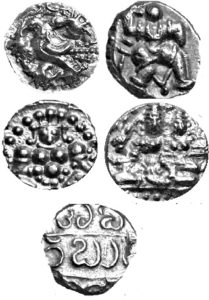
Some of Vijayanagara Coins
Coins of Sur Dynasty
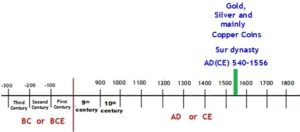
While Vijayanagara rulers were ruling in south, during the same period of their rule, another dynasty called Sur Dynasty ruled the northern part of Asia for a shorter period. The rule of Sur Dynasty assumes importance because of the Coinage system introduced by the King who established the Sur dynasty. After Ibrahim Lodi was defeated by Babur in AD(CE) 1526, the Afghan chiefs under the leadership of Sher Shah Suri, a Pashtun Afghan ruler established Sur Empire and came to power to rule northern part of South Asia from AD(CE)1540 to AD(CE)1556 stretching from a major portion of Afghanistan to Delhi.
The Sur dynasty held control of nearly entire Mughal territories, from modern-day eastern Afghanistan in the west to modern-day Bangladesh in the east. The empire however was in power for only sixteen short years though the Coinage system of one of their Emperors Sher Shah Suri was one of his most outstanding achievements of his rule. Emperor Sher Shah Suri found on his accession that the coinage system had practically broken down. When he realized that with the circulation of several types of Coins issued under different rulers caused total chaos as there was no fixed value between Coins of different metals, he abolished all the old Coins in use.
Next, he abolished all old and bimetallic Coins and issued Silver Coins in the name of Rupees. His silver rupee Coins weighed 178 grains. After minting several Silver and Copper Coins he fixed a basic rate for the Copper and Silver Coins and issued differential valued Coins in them such as halves, quarters, eighths and sixteenths of the basic Coins. He was the first to introduce the term Rupee for the metallic currency issued. The Copper Coins were called Dam and the Gold Coins as Mohur. The Silver Coin were known as Rupiah.
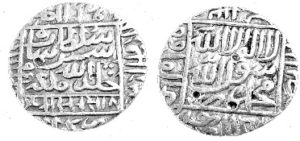
Attribution: Drnsreedhar at the English language Wikipedia
Coins of Moghul Dynasty
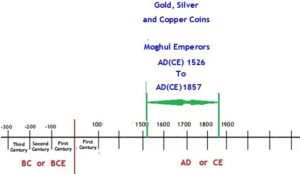
The name Mughal or Moghul is a corruption of the Persian word for Mongol, the Central Asian tribe after whom Mongolia is named. The Mughals are reportedly descendants of Mongol ruler Genghis Khan and Timur the great conqueror of Asia.
The Mughal Empire was established by Babur, prince of Timur ruler from Central Asia. He established the dynasty of Moghul rule after defeating Lodi in AD(CE)1526 and ruled most part of India. The first famous six Mughal emperors of the Mughal dynasty were Babur, Humayun, Akbar, Jahangir, Shah Jahan, and Aurangzeb. Their rule lasted till Britishers overrun them and converted India into a British Colony in AD(CE).
The Moghul emperors adopted and standardized the the Coins in the name of ‘rupee’ and ‘dam currencies’ in Silver and Copper as introduced by the earlier Sur Emperor Sher Shah Suri. The Mughals minted Coins with high purity on respective metals like Silver, Copper and Gold. Though various Moghul rulers had issued Coins, the Coinage gained more respect and importance only during the period of great emperor Akbar since there was all round development of the country during his period. Emperor Akbar has issued large no of Coins in Gold, Silver and Copper, minted from more than 100 places.
The historians say that acknowledging the better system of Coinage introduced by Emperor Sher Shah Suri of Sur dynasty, the Mogul Emperor Akbar continued to use Rupiah (Rupee) but inscribed his name on them. Lighter weight Coins were issued by Akbar in Silver. The Silver Coins were issued in the name of ‘Shahrukhi’ and Copper Coins in the name of ‘Dam’ which were extensively used by public in general. In order to differentiate the values of Silver and Copper Coins, the rate of exchange was clearly laid down.
The year of issue and the location of the mint where they were minted were also inscribed along with the full title of the emperor on the Coins. This practice was followed by subsequent Mogul emperors. The most interesting aspect in the Coins issued during the Moghul rulers were the absence of any symbol or portraits of the rulers on their Coins.
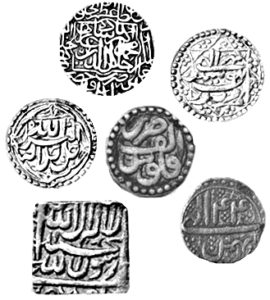
The Coins issued in Moghul period
Coins of Maratha Rulers
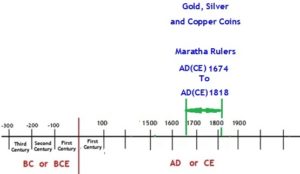
With the coronation of Chatrapathi Sivaji, the Maratha emperors came to power in the western region covering Maharashtra, parts of Madhya Pradesh and down south up to Tanjavur. They were in power from 1674 (AD(CE) to 1818 AD(CE) after destroying the supremacy of the Moghul rulers. Nearly eleven Emperors reigned as Maratha emperors in the shortest span of their rule which extended from Peshawar in the north to Thanjavur in the south. The Maratha are credited to a large extent for ending Mughal rule in India.
The rule of Maratha hierarchy continued as Maratha Confederacy which ruled different states in the name of Gaekwads of Baroda, Holkars of Indore and Malwa, Scindias of Gwalior and Ujjain, Bhonsales of Nagpur, Pawars of Vidharbha, Dhar and Dewas. They were all later declared Princely states by the Britishers. However their supremacy ended in 1818 in the battle with east India Company of Britishers.
Not much has been contributed by the Maratha emperors in the field of Coinage. Most of the Coins issued during their rule has been Copper Coins with different values based on their weight and size. The Coins issued by them were equivalent to 1/74th to 1/80th of a Rupee in the Indian subcontinent. The Coins issued were round in shape while few were also in square shape. However the Coins issued by the Maratha rulers were very poorly produced with dies much larger than the flans, lacked sophistication, varied in thickness, size and ornamentation. The Coins were also in the style of Moghul Coins or Hun of Vijayanagara Empire and perhaps this resulted in the inscriptions found in the Coins in Devanagari or Persian language without showing any other symbol or portraits. Besides Copper Coins some Coins in Silver and Gold have also been found issued by them.
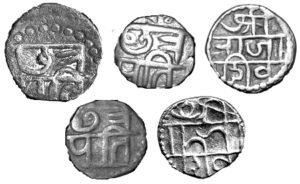
Coins issued by Kadamba Kings

A Brahman ruler Mayurasharma, scholar in Kannada established the Kadamba dynasty. Four different families of Kadambas ruled in southern India which was Kadambas of Hangal, Kadambas of Goa, Kadambas of Belur and Kadambas of Banvasi. Kadamba dynasty was founded by Mayurasharma in AD(CE) 345. Their ancestors were said to have migrated from the foothills of the Himalayas. Kadambas allies Chalukya of Banavasi ruled during AD(CE) 345 to AD(CE) 566. The Kadambas ruled Goa and South Konkan as the feudatories of the Chalukyas of Kalyani to begin with from AD(CE) 973 to AD(CE)1162.
During the regime of Kadambas, they have issued very heavy and purest Gold Coins which were of two types of Gold Coins. One type of Gold Coin was Punch-marked Gold Coins and the other type was Die struck Gold Coins.
The punched marked Coins had the image of Lord Hanuman besides image of Goddess Lakshmi in some Coins.
The Die struck Coins had the images of Lord Hanuman inside dotted circle, Conch and Cowries. The other symbols or images were Lord Sun and Lord Moon. Under the period of Jayakeshi-II, who was one of the Kadamba Kings, Gold coins stamped with their lion crest have been issued.

Courtesy:- https://en.wikipedia.org/wiki/Pagoda_(coin)

Coins of Kadambas
https://en.wikipedia.org/wiki/Kadambas_of_Hangal

Kadamba Kings coins in goa
https://en.wikipedia.org/wiki/Kadambas_of_Goa
Entry of East India Company and British rule in India- Status of Coins
It was chaos as far as the coinage was concerned when the East Indian Company, the shadow rulers of British rulers entered into Asiatic region. The entire Asiatic region was flooded with varieties of metallic Coins issued by different dynasties without specific face value or the exchange values attributed to them. Each part of the region had their own exchange pattern for trading with the metallic Coins they possessed. In southern part of India, Pagoda, the Coin issued during the period of ancient Hindu kings was the standard of value and also the medium of exchange and it continued to be so till East India Company entered.
The Pagoda was one of the metallic money issued in the name of Coins by various dynasties in medieval southern India, including the Kadambas of Hangal, the Kadambas of Goa, and the Vijayanagar Empire. The Pagoda was a unit of currency, a Coin made of Gold. It was subdivided into 80 Copper Coins or 42 Fanams which was a small Silver Coin issued as currency by the Madras Presidency until 1815. Following issue of Pagoda Coins of Kadamba Kings, two types of Pagoda Coins were issued by East India Company, French and Dutch rulers. East India Company issued Pagoda in the name of Star Pagoda and the Dutch issued in the name of Porto Novo Pagoda. The French issued in the name of Gold Pagodas on contract from Arcot of Nawab in South India.
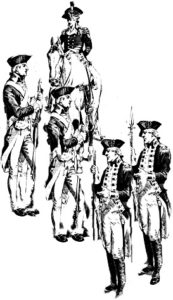 Before East India Company came, which was shadow of British rule established themselves, the unorganized money in the form of Gold, Silver and to some extent Copper Coins dominated several regions under several rulers. Unfortunately the exchange values or the denominational divides were not clear as everyone had their own standard and issued Coins in haphazard manner. There was vertical difference in the Coins issued by the Hindu emperors and that of the Muslims. While the Hindu emperors preferentially issued Gold Coins followed by Silver and Bronze, the Muslim rulers were specific in issuing Coins made of Silver in preference over other metals.
Before East India Company came, which was shadow of British rule established themselves, the unorganized money in the form of Gold, Silver and to some extent Copper Coins dominated several regions under several rulers. Unfortunately the exchange values or the denominational divides were not clear as everyone had their own standard and issued Coins in haphazard manner. There was vertical difference in the Coins issued by the Hindu emperors and that of the Muslims. While the Hindu emperors preferentially issued Gold Coins followed by Silver and Bronze, the Muslim rulers were specific in issuing Coins made of Silver in preference over other metals.
A brief on the East India Company need mention here as they were instrumental to the standardization of the coinage in Asiatic region. The East India an English company, formed by group of merchants in England as a monopolistic trading body for the exploitation of trade with East and Southeast Asia and in India was given the status of Royal charter by British Queen in the year AD(CE) 1600. When they landed in India initially they became a junior partner in the Mughal Empire’s commercial activities and slowly intruded into the subcontinental politics besides raising a large standing army consisting of Indian mercenary soldiers trained in European on military techniques. The East India Company thus established military supremacy over rival European trading companies and local rulers before taking control over the administration of the Bengal region within next few years. In the year 1818, after defeating the Maratha and Moghul ruler they took control over many parts of Asiatic region and India.
After the formation of the East India Company who set their foot in Asiatic regions in 16th century under the guise of East India Company, King Charles-II, gave them the right to mint their own currency in India. Utilizing the opportunity they set up first mint in the then Kolkata in 1672 and started minting and issuing metallic Coins as legal tender and soon over 14 mints came up in India. The East India Company’s Coins included Gold Mohur, Silver Rupiya, Pagoda, Anna, Fanams etc. Soon they extended the minting facilities to more mint stations in other cities in India like Madras, Mumbai, Surat, Ahmadabad etc. In the mint in Mumbai they produced Gold, Silver, Copper and Tin Coins in European style. Initially they produced Copper and Tin Coins to meet the local needs and later minted Silver Coins for transactions in trade. Subsequently after other mints were formed, they produced Gold Mohur Coins too.
The Gold Coins were called Mohur, Silver as Rupiah and other divisions as Pagoda, Anna etc. However in the year 1818 the East India Company abolished the status of Gold Mohur as legal tender and instead made only the Silver Coins as legal tender in order to enforce -one metal one Coin- policy to remove confusion in exchange. By 1835, they were able to enforce unified system of coinage throughout entire British possessions in India.
As metallic Coins continued to be exchanged for trading in some parts of the world, British settlers in India (who were British nationals not affiliated with East India Company) besides East India Company in the Southern and Eastern provinces traded with some format of money and commenced issuance of Coins in various metals of their own in addition to the issuance of paper money for trading when the concept of Paper money too emerged on the background. Between 15th and 17th Century, metallic money as Coins on Copper and Silver were issued by Britishers in the name of Rupees.
The traditional hand striking of the Coins was discontinued and machine pressed Coins was introduced. All the Coins issued were round in shape. In the year 1857-58 in the aftermath of the military and civil rebellion called Indian Mutiny against the British East India Company which saw huge loss of human life, control of India passed from the hands of East India Company to the Crown- British rulers. Coinage issued after 1857 went under the authority of the monarch as India became part of the British Empire.
Prior to 1835, the East India Company (British Govt) have issued Coins through Bengal Presidency, Bombay Presidency and Madras Presidency, the three Banks established by the East India Company (Banks of Bengal, Bombay and Madras). All the three Presidency banks issued their own Coins as one Gold mohur, two mohurs and in fractions of 1⁄16, 1⁄2, 1⁄3 and 1⁄4 rupee at various periods of time. Further, those banks also issued money in the name of rupees and fractions thereof down to 1⁄8 and 1⁄16 rupee in metals such as Silver, Copper and in Gold. Bank of Madras also issued two-rupee Coins much later. The Money issued prior to 1835 whether paper or metal, were called Sicca Rupees and those issued later were called simply Rupees.
The success story of Coins for trading led to the commencement of private banking system for transacting the business. The banks began issuing paper money in the 17th century replacing the metallic money partially. This is how the Britisher’s idea of introducing paper Currencies began to be developed in India. At one point of time the use of both metal and paper money were in vague across the globe. The Coins were circulated in local area for use in local trade. Thus the three Banks continued to issue both Metallic Coins and Paper money till the Coinage act 1835 was enacted.
When the 2nd World War began in the year 1939, it lead to the shortage of Silver and thus the price of Silver rose very high. When the metallic value of the Silver Coin surpassed its face value (value of metal per Coin including the processing cost etc for the finished piece of Coin), the Government decided to issue the pure Silver Coins in combination with different other alloys. Thus pure Silver Coins were replaced by the metallic Coins made in combination metals like Copper plus Nickel i.e as Cupro nickel Coins.
When uncertainty in Europe on account of World War caused fluctuation in the value of metals, slowly the banks had to shut down their operation on the issuance of metallic Coins on account of declining profits. Most of the metallic Coins in vague then were in Copper and Silver weighing particular grammage and issued against certain value of paper money.
For example when the weight of a Silver Coin issued was 20 gms and valued as one rupee, it became obligatory to issue one Silver Coin weighing 20 gms against one rupee note whenever produced in the bank. When the value of the Silver went up and equaled to 1½ rupee, still one Coin of Silver weighing 20 gms had to be issued against one rupee note produced resulting in a loss of ½ rupee per every one Coin exchanged against one rupee paper money. This resulted in huge loss to the banks as they had transacted with huge quantity of Coins every day and such issues were not anticipated in advance.
All such aspects and anomalies were studied and well taken care of to prevent incurring loss in banking operations while issuing the metallic money after enacting the Coinage act. Some of the measures taken to prevent losses were by readjusting the weight of metallic Coins to match the value of the paper money for the same value of Coins issued. All such factors hastened the thinking to issue more paper money instead of issuance of metallic Coins.
From plain Steel for minting money, bimetallic metals like Copper and Steel came to be used followed by Silver, Bronze and Gold. The metallic Coins with some images impressed as seals were adopted across the world as money.
Even after take over of India by the British Govt, hundreds of semi-independent Princely States existed in India which were not formally ruled by the British, but were ruled by regional leaders. Though they were all independent states and ruled by different princes and Nawabs, they were in discreet alliance with the British rulers whose support was needed at time of crisis of any form. The Princely states like Awadh, Rampur both in U.P, cities like Bahawalpur, Bela (presently in Pakistan), cities like Bhairaghat, Dhar, Gwalior, Guna, Bijawar, Jaora, Jhabuwa, Panna, Rathlam, Rewa, and Bhopal all in the present state of Madhya Pradesh, Baroda, Kutch, Porbhandar, and Bhavanagar all of them in the present state of Gujarat, Parthabgarh in Orissa, cities like Jaisalmer, Bhanswara, Bikanir, Jodhpur, Kuchavan, Kishangardh, Junagadh, Kota, Bijawar, Bhikanir, Mewar, Narwar, Jaipur and Bharathpur all of them in the present state of Rajasthan, cities like Kolhapur, Lunavada both in present state of Maharashtra, Mysore (Karnataka), Travancore (Kerala), Arcot (Tamilnadu) have all issued Coins of their own with motifs and symbols like name of rulers, Portraits of ruler, Coat of Arms, Flower, Horse, Elephant, Fish and Geometric designs with legends in Devanagari language etc. A majority in them have issued Coins in Copper while a few have issued Coins in Silver. The Coins were round, square and some irregularly shaped.
The circulation of non standard metal Coins (in respect of weight, size, and shapes) belonging to several periods of rulers and the Princely states who issued them at their fancy without assigning specific value per Coin caused several working problems. The metallic Coins in the form of money of one area or territory could not be exchanged with the same valued Coin or used outside their territory in which the rulers of the territories have issued Coins for their own people. Slowly the Princely states came under the control of Britishers.
Initial Coins issued in India carried the portrait of Mogul Emperors and Muslim Kings. When British gained control over the Princely states, the supremacy of Mogul rulers ended resulting in the replacement of their Portraits on Coins with that of Monarchs of Britain. Thus the dominance of Mughal over India started diminishing after Britishers arrived in the country, not only on the portraits of the Coins, but also on the paper money on which the portraits of Monarchs of British emperors and Queen replaced the portraits of Mogul Emperors.
Against those developments when the Coinage Act 1835 was enacted, the issue of Coins came directly under the Govt and to standardize the Coins. As per this act, the weight of the rupee Coin was standardized at 180 grains troy (one Tola) in which 165 grains should be pure Silver and remaining 15 grains would be alloy. Besides the weight, other aspects like multi composition of metals, their shape, overall size and design element on both sides were also standardized. The rupee Coin bore the effigy of the British Emperor.
This act was enacted by the Government under British rule after taking into consideration the confusions and chaos arising out of nonstandard weight of individual Coins, their fineness and uneven size which were in circulation in different areas as issued by different rulers at different periods of time.
The next development was in the aspect of ease in handling and carrying. Even during the period of Kings and Monarchs or the British Govt who issued metallic Coins, most of the Coins were issued with holes in center which were meant for the twin purposes of reducing the weight of the Coins and also because the Coins could be chained together for ease in carrying while transacting the business outside the premises of the owners of those holding the money.
The value attributed to each metallic money were originally not based on the value of the metal because they were only representative Coins of territories in which they were issued. But over period of time when Coins in metals such as Silver, Gold, Bronze and Copper were issued, each of those metallic Coins developed a value in their own right which came came handy in evaluating the metallic money in use. Just to understand the above see the following imaginary example.
Let us say that ten Coins of different metals like Gold, Silver, Copper, Bronze, Lead and Iron, all with same weight were in use in different territories. If specific quantity of grain could be received against one Coin made of Iron, then twice the quantity of the same grain could be procured against Steel, three times quantity against Copper, and five times against Silver and ten times against Gold etc. This is because while Iron was easily available and much cheaper metal than Silver or Gold which are not easily available and therefore more grain could be procured with Silver and Gold. Besides, the metallic properties of Silver and Gold were much higher compared to Iron was hard to get. This is only a simple example to cite.
During Britishers rule Coinage act was enacted in the year 1835 placing the prerogative of issuing and standardizing the Coins with the Govt. However after India attained Independence, the Coinage act 1835 was amended as ‘Coinage act 1906’ which not only conferred upon the Govt the monopoly of issuing metallic Coins but also bringing the entire mints under its authority and control. Even after the formation of RBI this act has not been amended to transfer the authority of issuing the Coins to RBI. Hence the Govt of India is directly minting the Coins in the mints under their control however in consultation with RBI, who places annual indent for the supply of Coins and the Govt draws up the production plan to supply Coins to RBI.













Recent Comments